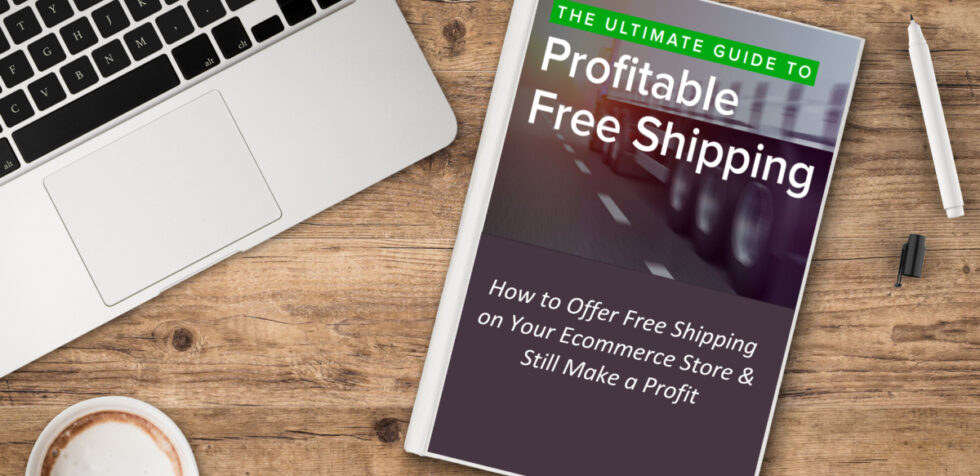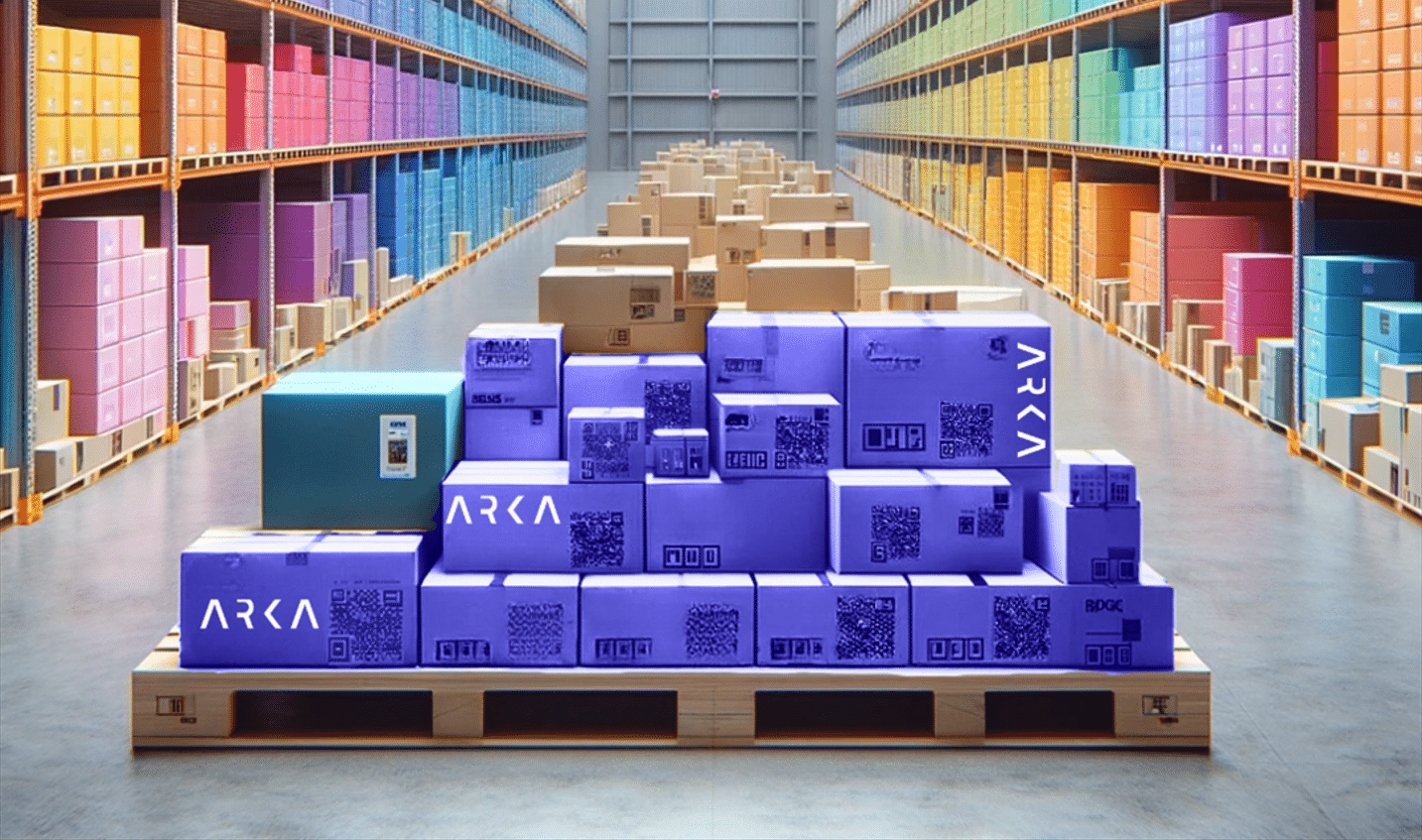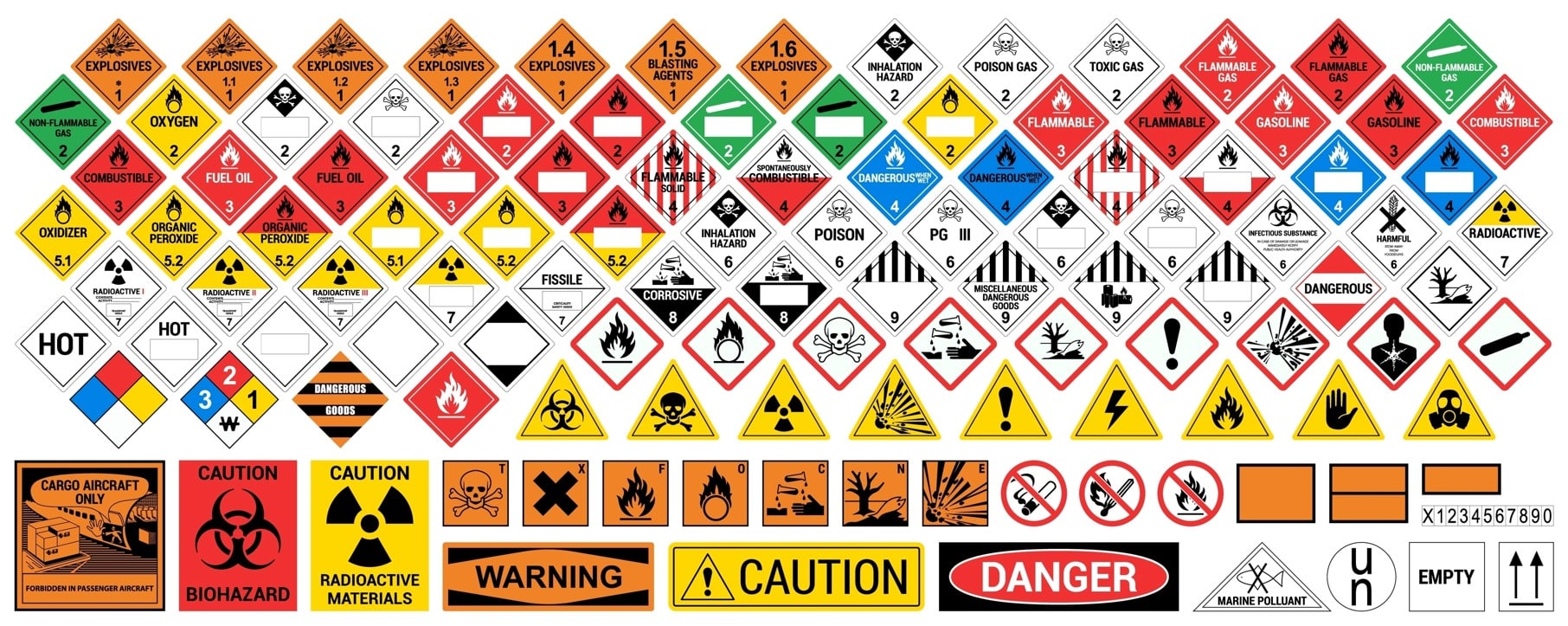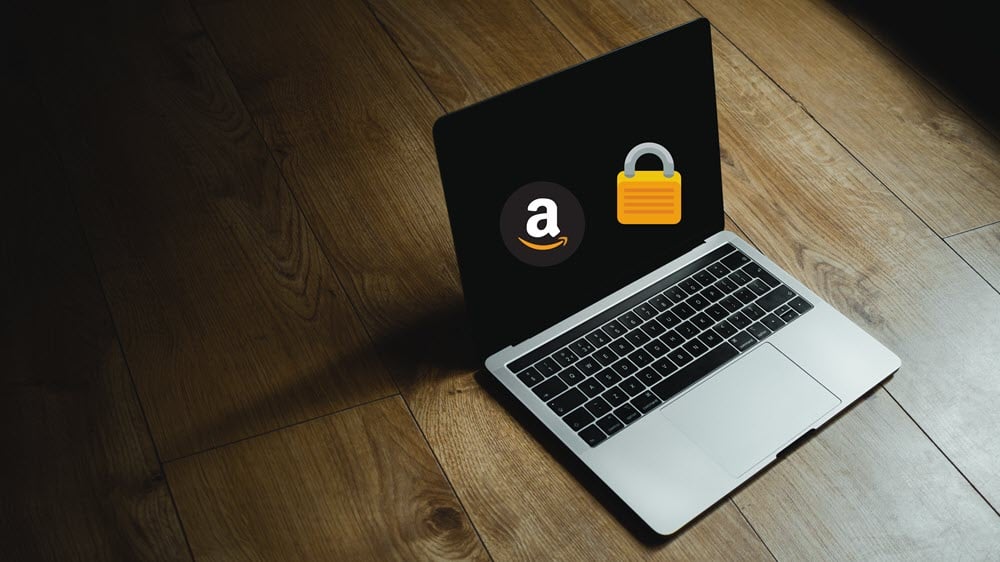Download The Ultimate Guide to Profitable Free Shipping
How to offer Free Shipping on Amazon | How to Offer Free Shipping on Walmart | How to Offer Free Shipping on eBay
How to offer Free Shipping on Shopify | How to Offer Free Shipping on BigCommerce | How to Offer Free Shipping on Magento
Get 50 Proven Shipping Strategies in This Ultimate Guide
For any online seller wanting to get ahead of the pack, it is a must to offer free and fast shipping. But shipping is not really free for you and can creep into your margins. We have created THE ultimate guide on how to offer free shipping and still make a profit. Keep reading to learn 50 proven ways you can offer free shipping profitably and radically improve your order fulfillment.
To kick it off, we’re starting with our top 5, tried-and-true shipping methods:
1. Structured Negotiation with Multiple Carriers
Shipping costs are easily the biggest component of your order fulfillment prices, worse if you happen to sell big bulky items. But the problem is, every year the carriers increase their rates while you have to keep prices low to stay competitive. Giants like Amazon can afford to subsidize their deliveries but what are you to do to offer free shipping as a small businessman?
Well, a lot.
With Amazon itself getting into the freight and shipping business, other carriers like UPS and FedEx are doing all they can to retain their customers. For these carriers, every bit of business is important. This presents you with the perfect opportunity to pull up your socks and put on your negotiation cap.
The key is shopping around and negotiating with your carrier account manager (if you have one). Chances are you’ll get a better deal if you can convince carriers that you are a reliable source of repeat business. First, you’ll have to gather what your business’ shipping needs are and then you formulate a formal Request for Proposal (RFP). This RFP document will help carriers assess your needs and tailor a deal for you. It’s easier to distribute this document across multiple carriers rather than setting up one-on-one discussions with everyone too early in the negotiation. For more details, Logiwa does an excellent job of explaining how to go about it.
 There’s a merit to being well prepared for your negotiation. Be sure to really understand what sort of shipping profile your business have, ranging from:
There’s a merit to being well prepared for your negotiation. Be sure to really understand what sort of shipping profile your business have, ranging from:
- Breakdown of shipping speeds you need historically
- Different sizes of packages needed and their dimensional weights
- Percentage of residential vs. commercial deliveries
- How often errors and corrections like address changes and incorrect weights occur
Having a clear sense of what your business really needs helps you avoid paying for features you don’t really need in your deal with the carrier and makes sure you negotiate for the items that you use the most. Pulse commerce also has a great in-depth article on how you can negotiate better rates using shipping data and analytics.
Pros:
Taking the time to assess your needs and building an RFP will pay off because it comes with a few benefits:
- It becomes easier to negotiate with multiple carriers at once
- The RFP can be repurposed to negotiate with suppliers, warehouses and software solutions
Cons:
Negotiating a contract seems like a solid way to lower your shipping costs but there are a few things that you should keep in mind:
- You get locked-in with the carrier. This might mean you lose out on any short-term discounts other or new providers give out.
- Your shipping needs may change. If you change your SKU assortment, you might no longer be able to ship at the negotiated rates for new sizes and weights.
- If the carrier is sloppy with your deliveries, even if you get reimbursed, few unhappy customers can really drive your business into the ground.
Download The Ultimate Guide to Profitable Free Shipping
2. Convince Suppliers to Use Your Shipping Account
You might be leaving money on the table if you use your shipping account for only outbound shipments. Most ecommerce sellers get inbound inventory shipments from their suppliers. If you’re one of those merchants, it would be a good idea to convince your suppliers to send them using your shipping account, meaning the carrier will bill you directly for the inbound shipment. This translates to more shipping volume on your account, and if we learned anything from the first tip, the more volume you have the more bargaining power you’ll have as well. In addition, you might already hit a higher volume discount even before further negotiations.
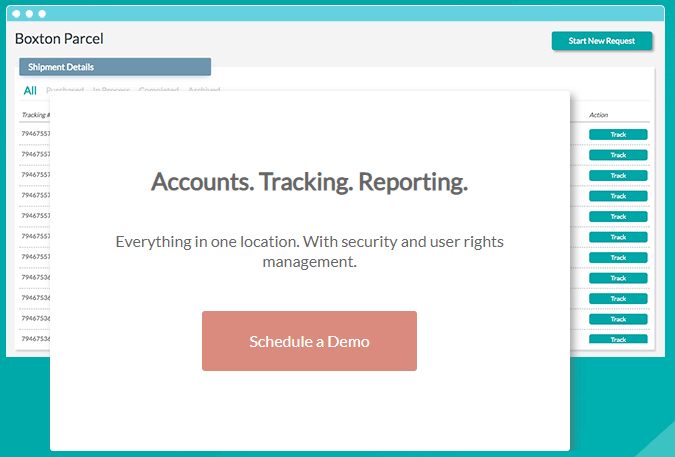 There are third-party solutions such as Boxton which let you manage account access rights for shipping with various partners:
There are third-party solutions such as Boxton which let you manage account access rights for shipping with various partners:
Pros:
There are two major advantages:
- It increases your sales volume so that you can negotiate better rates.
- It also prevents suppliers from marking up transportation costs in the invoice.
Cons:
However, you should exercise some caution. Your carrier account numbers are like a credit card number. Things can go wrong such as:
- If you have multiple suppliers or change your suppliers over time, your account could end up paying for someone else.
- It is often difficult and time-consuming to comprehensively audit your carrier invoices and claim reimbursements.
- It is also difficult to track which service levels the suppliers are using. They may end up using a more expensive shipping method over the most practical.
A simple solution would be to set up a process through which suppliers can provide all the shipment details to you and you can provide them with the shipping label. You can email those labels directly to them so that they can print and handoff the packages to the carrier.
Download The Ultimate Guide to profitable Free Shipping
3. Intelligently Set Minimum Order Value
It would be best to avoid delivering low-cost items for free as their shipping costs are often higher than the cost of the item itself, leaving only so much margin. Setting a minimum order value in your shopping cart helps you generate enough margin to recover some of the shipping cost. One study has revealed that about half of the shoppers will add additional items to their shopping cart just to qualify for free shipping, making a great case for setting a minimum order value for free delivery.
However, be mindful that there’s a fine line between setting a minimum order value that will increase total sales and one that will drive away the customers. There are different ways to test what that right amount is. Don’t set a limit too far away from your average order value. It should be just enough for customers to add a couple more items at most.
The following is a simple model developed by a data analytics company, RJ metrics:
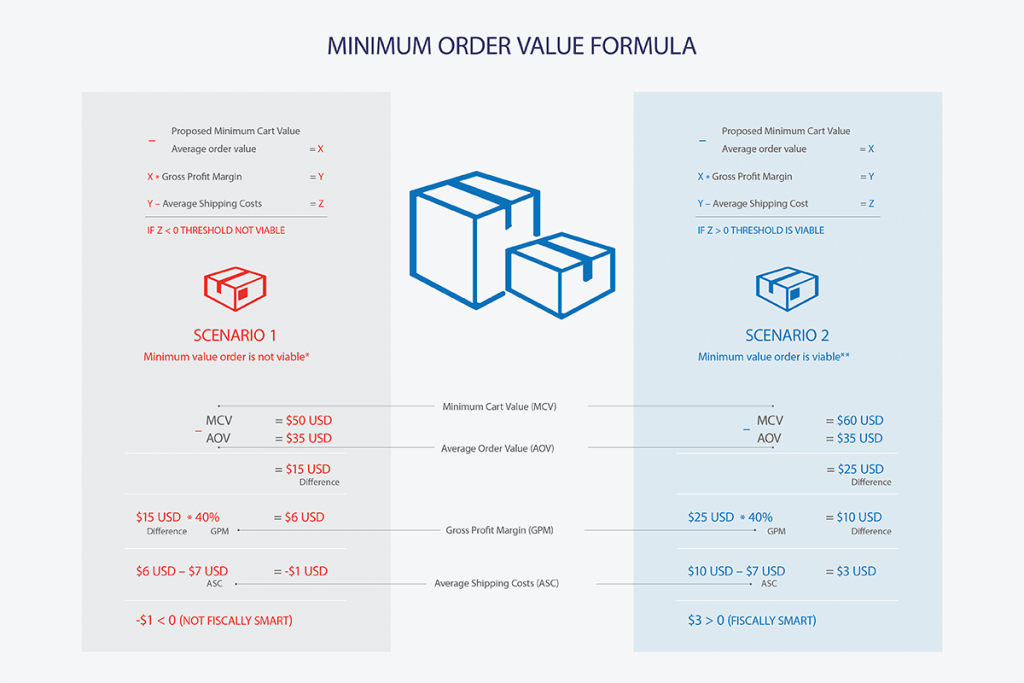
To learn more about calculating your minimum order value, check out this guide by Shipgooder.
Pros:
The advantages of having a minimum order value are:
- You don’t lose all your profit margin by spending it away on shipping cost.
- Your average cart size goes up, meaning on average your customer spends more every time she buys from your store.
Cons:
There are a few things you should keep in mind while using this approach:
- There’s a chance of your core customer base abandoning you for a better alternative and not coming back.
- If you are in growth mode, subsidizing shipping may be the only way to get your products out there and create a great track record of customer service. And hence, setting a minimum order value may not be in your best interest at this early stage.
Download The Ultimate Guide to Profitable Free Shipping
4. Use Trade or Group Association Discounts
Trade organizations such as the American Bar Association or the Outdoor Industry Association are not just good for their annual conferences and shows, but they also offer a lot more advantages to their members. One of them is working together to help businesses reach scale when buying goods and services.
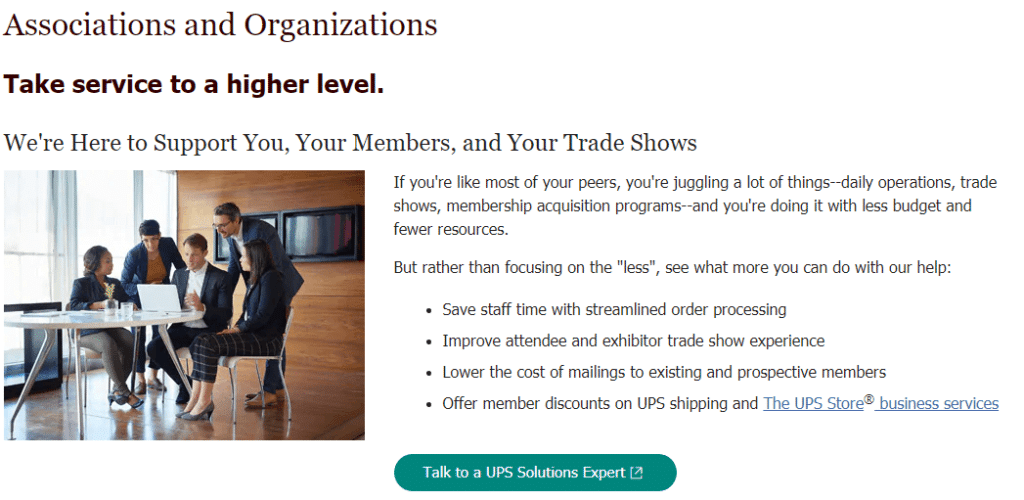
Shipping carriers often have relationships with many professional associations and offer member discounts. Depending on the size of the organization, you could be eligible for discounted rates of up to 50 percent with UPS and FedEx.
While UPS does not advertise the associations they offer discounts to, don’t hold back from asking your account manager or your association, whether you qualify.
Pros:
The advantages building a relationship with carrier through a professional association are:
- You don’t have to build a separate relationship with the carrier to get the discounts and other benefits
- The carrier will be able to provide the same discounts to you at trade shows organized by your association
Cons:
But there are a couple of things to keep in mind while doing this:
- You may not stay on as a member of the organization forever. Building a direct relationship may be a possible alternative for a long-term solution.
- Savings from the member shipping discount may be less than the cost of membership. However, you might receive other intangible benefits from associations such as the network and learning opportunities.
Download The Ultimate Guide to Profitable Free Shipping
5. Maximize Ground Shipping Usage
Free shipping is a great motivator for shoppers even if it means getting the delivery a little later in some cases. According to a 2017 survey by Bizrate Insights, 9 out of 10 shoppers are willing to wait longer for a free shipment. Hence, using the cheaper option of ground shipping may be your best bet.
Similar to tip #3 which aims to add enough margins in a shopping cart to make free shipping viable, an alternative is to provide free shipping but at a slower speed. Consider offering a no rush delivery option for your customers who are willing to wait for free shipping. Ground shipping uses trucks to ship around the country rather than air cargo, therefore reducing the carrier’s costs and giving you better margins.
Here are some possible options for ground shipping from different carriers:
FedEx Ground: Offers delivery to commercial destinations with the certainty of delivery on a pre-informed day. They deliver within typical business hours and the delivery duration is between a day to five days.
FedEx Home: This is like FedEx ground, but with deliveries to residential addresses. It is slightly more expensive and has a wider window of delivery between 9 am and 8 pm. The delivery duration is between a day to five days.
UPS Ground: UPS ground shipping is a ground delivery service with a guarantee of delivery on a specific date similar to FedEx.
USPS Parcel Post: The delivery duration, in the case of USPS, is between two to eight days. It is even less expensive than UPS and FedEx ground but takes 2 to 3 days longer.
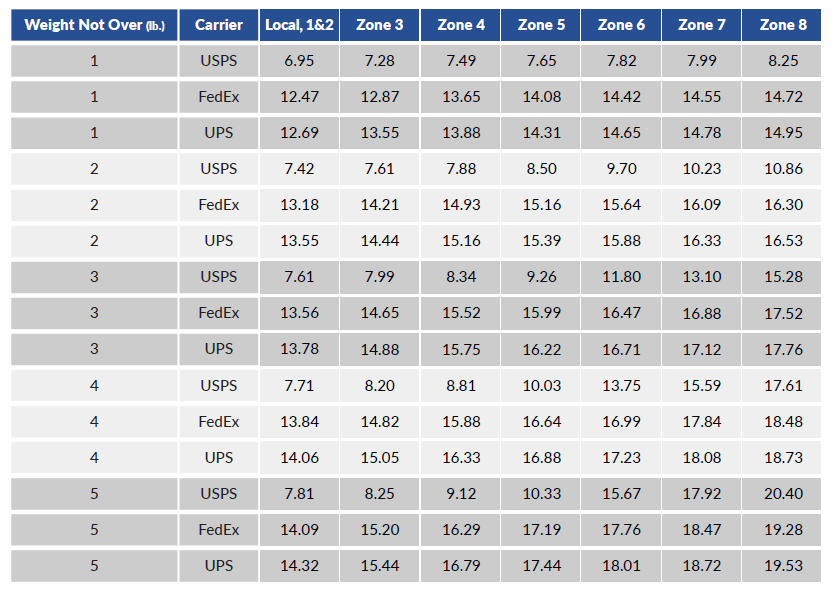
To help you decide which carrier to go with, check out this price comparison by Shipping Easy on the 2019 rates for ground shipping by different carriers:
Pros:
In the end, using ground shipping for your order fulfillment has its benefits:
- Compared to a 2-day guaranteed delivery service, ground shipping saves online sellers more than 50% in shipping cost.
- A slower shipment using ground shipping makes sense for products that do not fall under the ‘instant gratification’ category, in which delivery speed is very important.
- Ground shipping is the greener choice for the environment because truck and lorry deliveries produce up to 85% less emissions compared to air cargo.
Cons:
Ground shipping is not the ideal method for delivery though. If you stick to ground shipping, be ready to deal with the following issues:
- Buyers increasingly opt for the faster shipping method due to the norms set by marketplaces such as Amazon Prime
- If your items are perishable, they might not be able to survive the long journeys in a truck across the country.
- There could be delays due to unexpected stoppages and detours caused by weather conditions or accidents, affecting your customer experience.
Download The Ultimate Guide to Profitable Free Shipping
You can also see a quick video of this episode here.
Part 2 – Pricing Strategies
Pricing is one of the most determining factors of a customer’s buying decision. While customers naturally gravitate towards the lowest price, this expectation is now the norm thanks to marketplaces placing a high importance on low final prices (which includes the list price and shipping cost). If you look at any product page in Amazon, very likely the seller who has the buybox also has the cheapest offer. This price expectation puts pressure for online sellers to set a “just right” price that is both low but enough to provide free shipping. Shipping charge is an important component of online product pricing.
Points 6 through 10 will talk about five way to recover your shipping costs by strategically setting your prices.:
6. Include Shipping Costs in Product Prices
Remember the last time you were irritated about hidden resort fees during hotel checkout? Or that mysterious additional tax you didn’t know about when traveling to a new city? Similarly, customers perceive a surprise when you charge shipping separately to an item sold on your page which might lead to cart abandonment.
However, the shipping cost is an inseparable part of selling online. There should be no reason to treat this cost separately. What if you included the shipping cost in the price of the item?
Imagine having to pick between these two options for something you’re about to buy:
- Option 1: $30 + $5 shipping charge
- Option 2: $35 with free shipping
Bill D’Alessandro, of Rebel CEO, a consulting firm, ran this very test for a skincare product and option two converts twice as many sales. Several other studies have shown that customers are more likely to abandon the shopping cart when they see the shipping charge right at the end during check out.
How do you distribute shipping costs to individual item prices? One approach is to change the pricing of items below your free shipping threshold to include a portion of expected shipping cost.
Say a merchant offers free shipping for orders of $50 or more and on average shipping cost is $5. For a $25 item, add 50 percent ($25/$50) of the shipping cost to the item price. For a $10 item, add 20 percent ($10/$50) of the shipping cost to the item price.
If shipping cost on average is $5, the $25 item would now be offered at $27.5. The $10 item now has a price of $11. You still offer free shipping, but you’ll recoup a portion of the costs. Customers may prefer to pay $11 with free shipping versus $10 with $1 shipping.
Pros:
The advantages of including shipping costs in the product price are:
- The rate of cart abandonment goes down as there is more transparency from search to checkout.
- Your marketplace stands out with the tag of free shipping against other stores irrespective of the prices they are offering
Cons:
There are other factors that you might want to keep in mind before using this method.
- Landing customers on your page can become tougher with slightly higher prices; there is a potential to offset any advantage gained by removing shipping charges at the end of checkout.
- If the customer initiates a return, you need to refund the listed price including a part of the shipping cost baked into it.
- Customers buying multiple quantities would prefer a separate shipping charge on the whole purchase than higher prices.
7. Offer Free Shipping on Select Items Only
It is tough to offer free shipping for your entire SKU catalog when you sell everything under the sun big or small. But you can thoughtfully select which items to offer with free shipping.
It is often the items with low-margins, heavy-weight, and big-size that suffer losses from shipping costs. This should not stop you from providing your customer with free shipping on other items where the shipping cost is not a big chunk of the product price.
The key is communicating it effectively to the customer, being clear and upfront about such restrictions will help customers navigate your page easily and with trust. Here’s an example that Neil Patel demonstrates in this blog:

He goes on to show how there is a marked improvement in net profits with this experiment despite a reduction in margin per SKU. You can gain more profits because of the increase in sales and a positive margin per order.
Pros:
Offering free shipping to a limited selection of SKUs has its benefits, such as:
- Offering free shipping increases your sales volume, effectively negating any decrease in margin per single item.
- Free shipping as a way to recruit new customers, there will be upsell-opportunities when satisfied customers come back to your store.
Cons:
However, keep in mind these few things while implementing this shipping strategy:
- Free shipping on select items works best when you have at least one high-selling item with a low shipping cost.
- Promoting free shipping on one item may signal the customer that you specialize in that item only.
8. Enable Free Shipping on Large Orders
Setting minimum order value increases your margin so that you can recover your shipping costs. But the shipping strategy does not work for everyone. If you have a limited variety of items, the customer may end up abandoning the purchase because they cannot find anything relevant to them.
Quoting a minimum order value forces customer to find the item priced at a certain amount. It is easier to nudge the customers with a prompt that says, “free shipping when you buy 3 or more”.
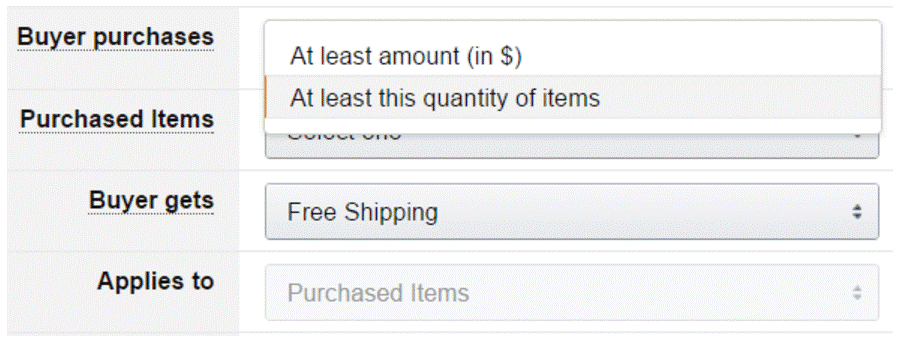
It works in case of items that are consumables that customers regularly buy, like personal care or household items. For these products, customers are used to expecting savings when buying in bulk or large packs. The end goal is similar to minimum order value in that the merchant can increase average order value and ship the items together to decrease the shipping costs.
Pros:
The advantages of bulk/quantity based free shipping method are:
- It’s easier for customers to add one more item of a product they already want to buy and will need to repurchase in the future.
- Packing multiple items is also time and cost-effective.
Cons:
A possible hindrance to something like this would be:
- It is mostly applicable only to marketplaces which sell items customers regularly repurchase over time.
- It will not be profitable for items that cannot be shipped together to reduce packaging and shipping cost.
9. Introduce Flat Rate Shipping Charge
If for some reasons, it is still not possible to bake shipping costs into your product prices, there is still a way to manage customer expectations. Customer will have less anxiety and surprises if they know the shipping charge they will need to pay irrespective of what they buy. They are more likely to find an item they want and complete the purchase.
Online customers are faced with a lot of options and must take into account many factors while deciding on a purchase. Therefore, making one factor very clear and straightforward will make the customer’s shopping experience that much easier. Customers respect the transparency from a merchant in a crowded marketplace.
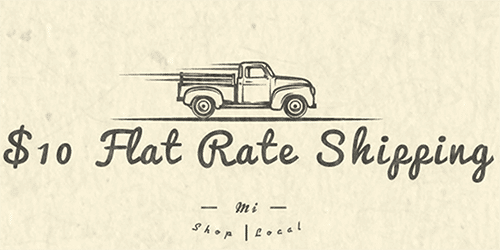
You should consider your average margin per unit and average shipping cost to calculate the flat rate to achieve positive profits. Here’s one online seller advertising flat rate shipping very effectively: “We don’t want our customers to experience sticker shock when they see the shipping rates at our store. Also, we want to make our online shopping experience straightforward and having a $10 Flat Rate Shipping charge lets customers quickly calculate their costs. That can’t be a bad thing, right?”
Pros:
Some of the advantages of flat rate shipping are:
- Sales increase as the customers will increase their average order value to make the most of the flat rate
- The shipping options on the product page are much easier to configure
Cons:
However, you should be careful about a couple of things:
- Flat rate shipping is not suitable for low margin items, depending on the flat rate you charge, such margin might not be enough when customers only order a single item during check out.
- It is also not profitable for items that have high shipping costs such as ones with bigger size, are heavy or need special packaging.
10. Adopt a Dynamic Shipping Charge
While the last tip focuses on providing a clear expectation of shipping costs via a flat fee, it is possible that customers may find other online sellers offering the same items cheaper. In some cases, if your order fulfillment center is close to where the customers reside, you might be able to charge a lower shipping cost than average.
Sellers typically apply a standard shipping fee during check out. There could be some customizations there. It could be related to the speed of delivery. Additionally, the zip codes are often used as a decider whether to offer free shipping or not. Nevertheless, there is a dollar amount imposed on the customer for shipping.
Typically ecommerce sellers calculate shipping charge using the average shipping rate for all their sales, a combination of different zones, sizes, and weights. So, some customers end up paying more than they should for their shopping while some others pay less.
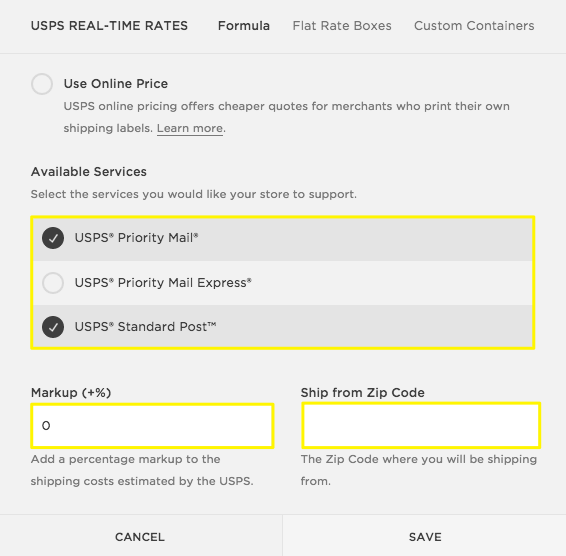
If your shipping charge imposed on the customer are higher than other sellers, because of the kind of item you ship (heavier, larger), your cart abandonment rate will be higher. On the other hand, offering free shipping for the customers in proximity will result in losing your margin.
With the same input of zip code, there is an opportunity to charge the customer the shipping fee tailored right at them. You can get real-time estimates of shipping rates right from your shipping solution. Connect your shipping solution right to the checkout page. This way, each of your customers will be shown a shipping charge that covers your shipping as well.
This blog by Squarespace explains one way to do it in great detail.
Pros:
The big benefits of having this system are:
- You can rest assured that you won’t lose money from shipping costs, no matter the location of customer or change in carrier rates.
- A portion of your customers will be rewarded for their proximity to your order fulfillment location, assuring you of their business.
Cons:
However, there are repercussions to imposing a dynamic shipping charge
- If your fulfillment location is away from the concentration of your target customers, you will end up charging your core market more-than-average shipping cost
- Temporary spikes in shipping rates may result in a customer lost for good, establishing your reputation for high costs.
You can also see a quick video of this episode here.
Part 3 – Exploring Your Carrier Options
Carriers are one of the most important stakeholders in running an eCommerce business successfully. Although every order involves some action through your carrier, you might not be using all the services that your carrier has to offer in fulfilling those orders. Selling on online marketplaces can be exhausting, and you don’t always have the time to figure out what’s best for you.
In this part, we list down the most effective ways you can lower your shipping cost by exploring your carrier options.
11. Take Advantage of ‘Hybrid’ Shipping Services
Hybrid services like Surepost by UPS and Smartpost by FedEx can help you cut your costs by half if you qualify for their weight and size restrictions. Hybrid shipping services are ideal for packages weighing between 2 to 10 pounds that don’t meet the criteria for a postal flat rate shipment. Packages lighter than 2 pounds should use USPS first class shipping or Priority Flat rate box and packages heavier than 10 pounds should use Standard shipping methods. Outside of this sweet spot, the prices for hybrid services may be comparable to other service types but hybrid services will take longer to deliver.
Hybrid services are a great example of how competitors work together to increase value by working in their area of expertise. The most expensive component of shipping is the last-mile delivery. The ground distribution network, especially in residential areas, has never been a strong suit of large national carriers such as UPS and FedEx. Instead, UPS and FedEx inject these packages into the USPS distribution for last-mile delivery, effectively outsourcing the final delivery stretch. This collaboration saves a lot of order fulfillment costs for them, making it possible to charge less.
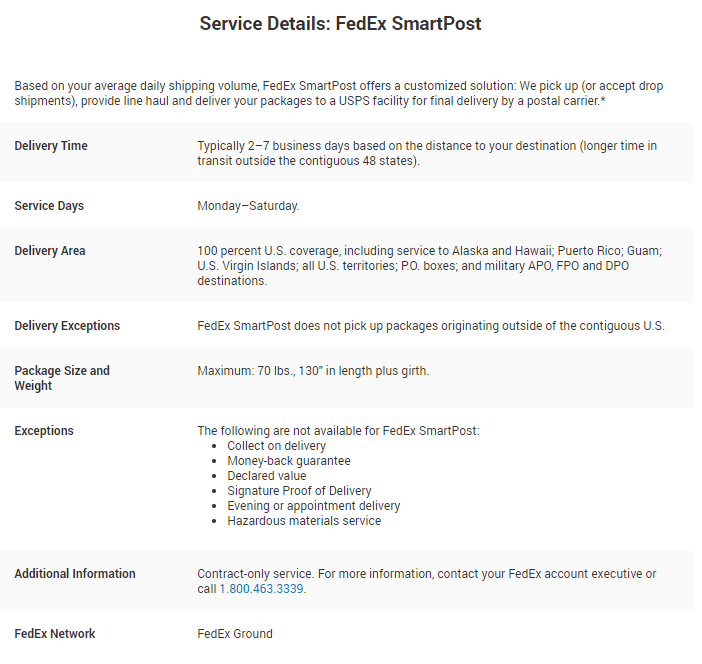
An example would be FedEx SmartPost, which provides the last mile delivery to every US address using USPS services. Although, recently FedEx has started to use its own trucks to do even the last mile as it tries to fill it’s unused capacity as a result of its recent infrastructure expansion.
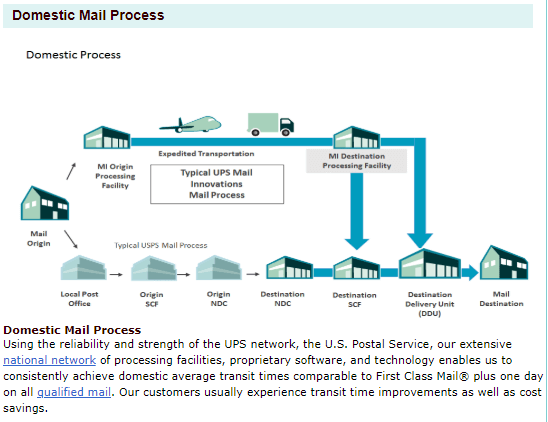
UPS also offers the same service for domestic and international orders through Mail Innovations and UPS Surepost. Here is a visual explanation of their Mail Innovations process.
Pros:
The advantages of using a hybrid shipping service are:
- Enjoy the long-distance speed of private carriers and last-mile efficiency of USPS, saving you up to 50% in cost.
- No surcharges for residential deliveries or special territories
Cons:
However, there are some things you might want to keep in mind while going for hybrid deliveries:
- Slower than standard shipping and it lacks a guaranteed delivery date.
- Availability is limited. Due to hybrid’s lower margins compared to standard shipping, carriers only offer this service to select merchants
12. Consider a Regional Carrier or Regional Rates
Some carrier services operate in specific regions only, they are often less expensive compared to FedEx or UPS because they operate in a smaller area and use mainly ground transportation for delivery. Their delivery networks are typically limited, but many of them cover wide ranges of states and fast deliveries as well, some of the prime examples of such carriers are:
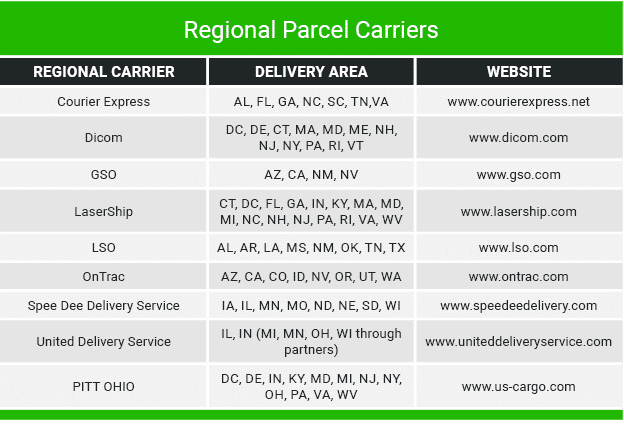
Regionals carriers typically provide better services than national carriers because they specialize and operate in a smaller area. They can provide same day or next day delivery options for deliveries that usually take a couple of days through FedEx and UPS.
They are more flexible in accommodating the requests of online sellers too. Since they have a smaller base of customers and fewer packages to handle, it is not uncommon for them to provide later pickup time and earlier deliveries.
Pros:
The advantages of going with a regional shipper are:
- You can save about 10% to 40% on your shipping costs compared to UPS and FedEx.
- Options for same-day or next-day delivery are greater when compared to the national carriers.
- The service windows are more flexible with earlier pick-ups and later deliveries when compared to the national carriers.
Cons
There is always a risk of partnering with regional carriers due to their relative inexperience and size
- The consistency of service over a longer period of time may vary depending on the maturity and financial state of the often-smaller regional carrier
- The services are only available in a geographically bound area. You will have to use national carriers or other regional carriers for different areas, adding complexity to your order fulfillment.
- You might lose out on volume-based discounts with FedEx or UPS. Carefully analyze the impact on discounts before diverting some of your deliveries to a regional carrier from national carriers.
13. Support Local Courier Services Like Postmates, Uber, Instacart, Etc.
Local courier services such as Postmates and Instacart offer instant delivery from select stores to customers in exchange for a delivery fee. Though the end customer does not always get free shipping, customers are used to paying extra for instant delivery through these couriers. Some also provide a subscription service offering free deliveries, which can help relieve the customer’s anxiety of paying for shipping.
Courier services generally have three stakeholders: the businesses who are listed to sell their product in an area, the drivers who deliver the product, and the consumers who order the product. Businesses pay a portion of their total order value to the courier service as a fee for listing and delivering their product instantly (usually less than an hour). Fortunately, this fee is typically much less than the conventional shipping cost for same-day delivery.
Courier services enable an “on-demand economy” where customers seek instant gratification from the convenience of their home. It has grown beyond food ordering & ride-hailing and now anything available locally can be ordered on demand.
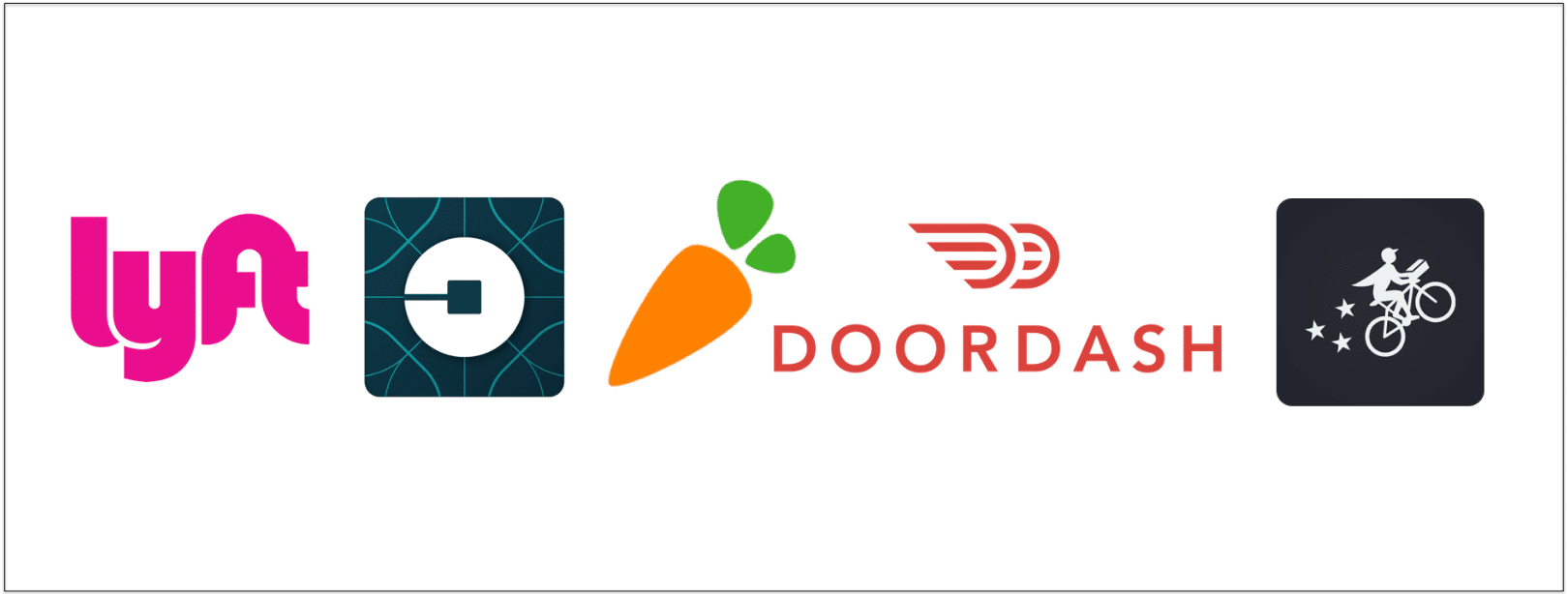
One study shows 41% of the adult population had used one of these apps in 2017, and it is a great way for a seller to increase their online footprint. It makes a great case for adopting instant courier delivery for your store, especially for ecommerce sellers catering to urban customers with an order fulfillment center in the area.
Pros:
The major advantages of using an on-demand courier service are:
- It is the fastest way to deliver products to your customers.
- The delivery costs are split between the customer and the local business, reducing the burden of shipping costs.
Cons:
- An online seller must be available to pack and ship the order throughout the day for the hours listed on the app.
- The delivery experience for the customer may be erratic due to the on-demand workforce compared to standard delivery service by carriers
14. Use Online Shipping by Carriers
Online shipping is an easy alternative for sellers who are new to ecommerce and haven’t reached the volume to qualify for negotiated rates or discounted 3PL services yet. You can print your shipping labels online instead of at the post office counter and enjoy reduced rates. It can be done via USPS’ website or through authorized USPS postage services like Endicia claims savings of up to 40% on USPS orders, whereas Stamps.com can save you up to 30% on priority mails. Online shipping with USPS also saves you from carrying all your packages to the post office with its free parcel pickup service.
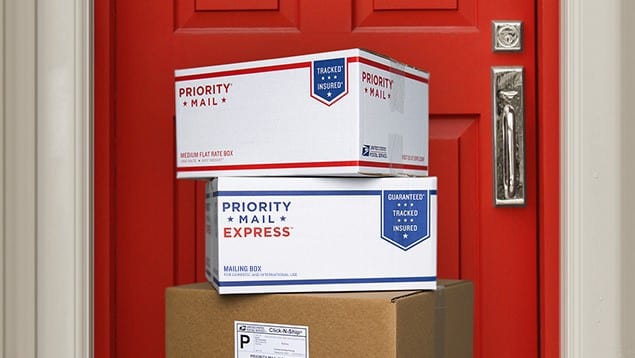
Using USPS is ideal only if you are shipping packages weighing less than two pounds. For heavier packages, it’s less expensive to go with the private carriers (FedEx and UPS). For private carriers, it’s best to open an account online rather than shipping them through the physical counters. These carriers reward the Do-it-yourself mentality! If you pay & print labels online and drop them off at the carrier store, you can save up to 50% compared to doing all of this directly at the carrier’s store.
Pros:
There are a host of advantages when you buy shipping online:
- Online shipping makes it easier for merchants to compare and select the right service for the desired delivery window and affordability.
- If you go with USPS, you can have your package picked-up directly from your location for free — no more trips to the post office.
- Easily add extra instructions such as ‘signature required’ or other services such as redirecting the package while on its route right from your own computer.
- Email notifications, so you have updates sent to you instead of checking tracking numbers one by one on their website. This way, you can update customers on delivery status quickly.
Cons:
Online shipping is a great starting tool. But there are a few things to worry about as you scale:
- It can be time-consuming to do it yourself manually as you grow and send more packages. You may need to explore more sophisticated solutions like multi-carrier shipping software and 3PLs.
- Express and guaranteed deliveries over long distances will still be expensive, so you will need to explore other ways to reduce those costs.
15. Avoiding Residential Addresses Surcharge
UPS and FedEx, the biggest national carriers, add a surcharge for all shipments to residential addresses. Carriers’ definition residential addresses aren’t always clear, but you can reduce some of your costs by planning around residential surcharges.
UPS defines a residential delivery as delivery to a location that is a home, including a business operating out of a home.
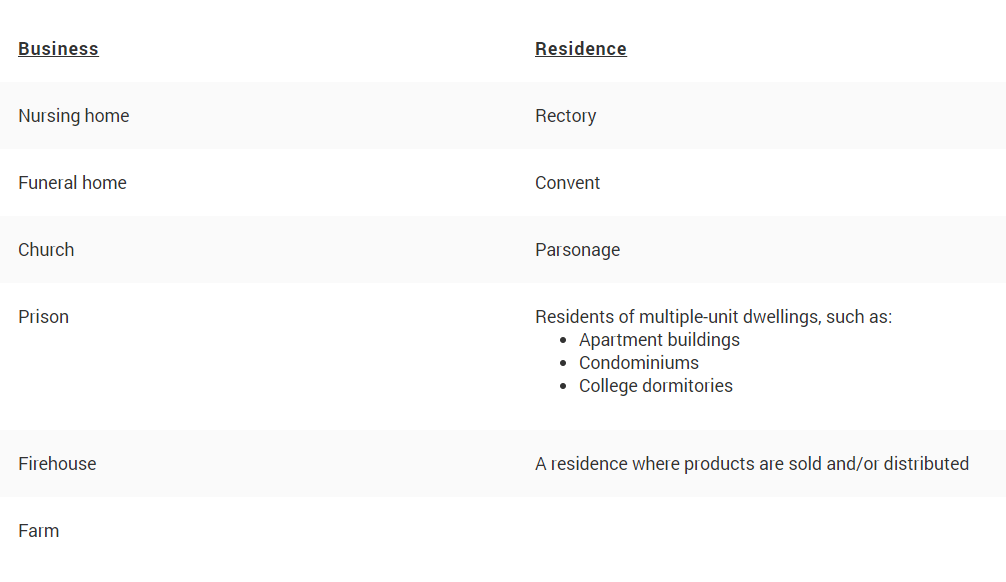
FedEx also adopts a similar definition of the residential addresses, to be completely sure you can enter addresses in your account to check their status. FedEx provides a helpful example list of addresses here.
You can find the complete list of surcharges for FedEx and UPS on their site here.
Carriers impose a residential fee surcharge because, to them, it is more expensive to deliver. A courier can deliver many packages to different businesses in a single trip to a commercial building, whereas typically a courier makes one delivery to a single residential address. It is this discrepancy that made carriers charge a residential surcharge.
It’s important to choose the right shipping method to avoid surcharges. For example, FedEx Ground is cheaper than FedEx Home Delivery, but when shipped to residential addresses will incur a surcharge of $4. However, FedEx Home Delivery is 35 cents cheaper compared to FedEx Ground+Surcharge. Imagine, with 2000 incorrect labels per month, you’d be missing out on ~$700 worth of savings!
So how do you go around it? One way is to utilize the services such as UPS Surepost and FedEx SmartPost as outlined above to eliminate your residential surcharge. However, keep in mind hybrid services do not give you a guaranteed delivery day and take longer.
Also, analyzing your past shipments will help you understand how much residential surcharges have you been paying so you can take action accordingly. The surcharges may not seem like much, but when shipping high-volume packages and utilizing the wrong network, they can add up quickly and can accumulate many lost dollars.
The solution is to separate your deliveries for home and commercial addresses and select delivery methods accordingly. While we can’t force the customers to only ship to a commercial address, you can make it easier by asking the customer to identify in the address type if it is a commercial or residential address. Lastly, there are intelligent shipping software solutions like Cahoot that provide address identification and verification besides buying and printing your labels to help you ship as inexpensively as possible.
Pros:
The advantage of doing this is:
- You save some per order but can amount to sizable savings on your total volume.
- You can use address type of customer to personalize messaging for your targeted advertisements.
Cons:
However, doing this does bring in a hassle.
- In the absence of a good shipping software doing it for you, you will end up spending a lot of time correcting and sorting addresses for a large volume.
- Each carrier has their own identification for an address being either commercial or residential, and when comparing service types across carriers, this can be inconsistent.
Choosing the right carrier strategy is important in keeping costs low but still provide good service. Cahoot’s shipping software and order fulfillment network automates this process and provides you the most affordable options for the desired level of service every time.
You can also see a quick video of this episode here.
Part 4 – Marketing Strategies
Innovative marketing is essential for any online seller to stand out in today’s world of fierce competition. In the headphones category on Amazon, for example, there were seven new products from two new brands added to the top 100 list every day last year.
Free shipping can be leveraged as an excellent tool in clever marketing campaigns by treating shipping cost as a customer acquisition expense. This part of the ultimate guide will focus on using promotions ed around free shipping to acquire new customers while preserving your long-term profits.
Below are five ways to offer free shipping through smart marketing strategies:
16. Offer Free Shipping with Loyalty Programs
Loyalty programs are customer memberships offered by retailers in exchange for various perks, including free shipping. The customer is charged a fee or must collect points against regular orders to enjoy the perks of the membership. It is designed to encourage repeat purchase, enabling retailers to absorb the shipping costs.
Some big retailers offer the membership to customers solely in exchange for their basic personal details such as email account, name, address, gender, and birthday. Retailers use this information to encourage more purchases through targeted marketing efforts. They leverage customers’ purchase history and demographics to send special offers and personalized catalogs.
The increase of purchase frequency from a loyalty program is reflected in the customer lifetime value (CLV), which is the basis for most loyalty programs. CLV refers to the dollar amount that a customer is worth to you between their first and last purchase with your business. It is easy to calculate with a formula:
CLV = (Average order value) x (Average gross margin) x (Average Number of transaction per customer over a year) x (Average lifespan of a customer in years) + (Loyalty program fee per year) x (Average lifespan of a customer in years)
For a loyalty program to be successful, CLV should increase when compared to CLV without the loyalty program. Let’s walk through an example. Before loyalty programs, your average order value was $50, Average gross margin was 20%, the average number of transactions per customer over a year 8, and customers only stay for 1 year. We assume customer lifespan on your store to be a year. Then,
CLV=$50 x 20% x 8 x 1 + 0 = $80
Now suppose you offer free shipping for a yearly fee of $50, you see a few changes in your metrics. Your gross margin goes down to 10% because of $5 assumed shipping expense per order, but the customers are likely to stay with you for twice as long (that is two years). In this case,
CLV = $50 x 10% x 8 x 2 + $50 x 2 = $80 + $100 = $180
Since there is an increase in CLV despite a decrease in gross margin, the loyalty program worked in this case. And this estimate has not accounted for increased purchase frequency from customers wanting to take more advantage fo the free shipping.
Even if you don’t charge a monthly fee, the point system is a good alternative. The points-based system encourages customers to keep shopping and take advantage of free shipping. Also, it can be designed to ensure there is enough additional margin to make up for shipping costs. Another driver of sales is the tailored offers and product catalogs, as mentioned previously.
Loyalty programs, in some cases such as supermarket cards, end up being a discount program without getting any more loyalty from the customer. Customers get membership cards from all supermarkets they visit and continue with similar order value with an added discount. Therefore, it is necessary to design loyalty programs to increase your profitability and reward increased spending.
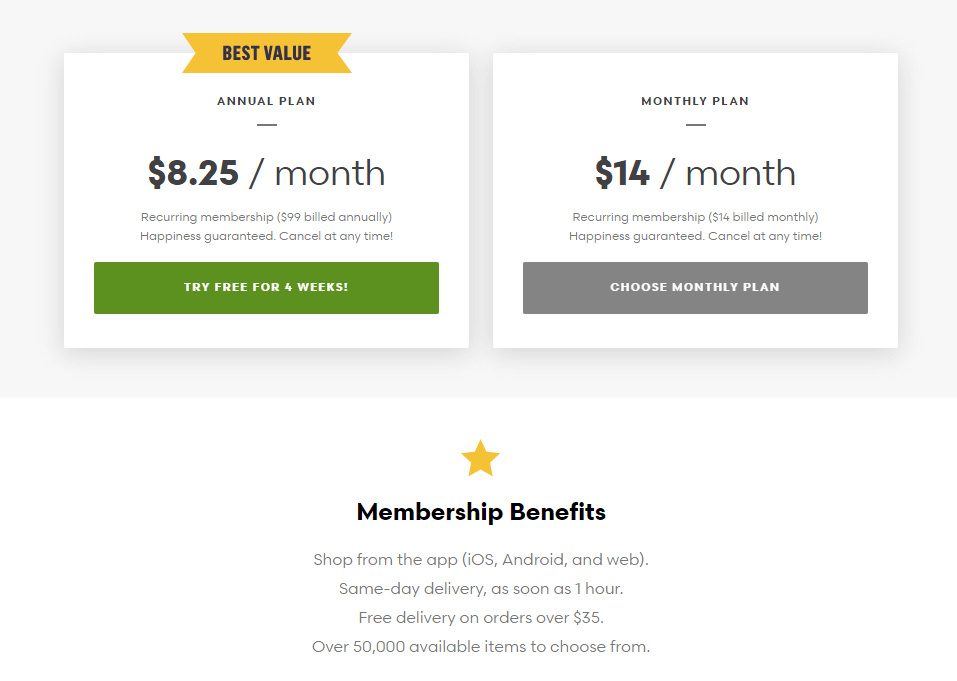
A few good examples of membership programs designed around free shipping would be Instacart, Shipt, and Newegg Premier. Instacart and Shipt’s annual memberships provides free grocery deliveries for orders $35 and above at $99 per year, which basically encourages a monthly shopping behavior from its members (per delivery fee is ~$8). Newegg’s $49.99 annual membership provides free shipping and returns, which also incentivizes customers to purchase from Newegg frequently to make it worth their while.
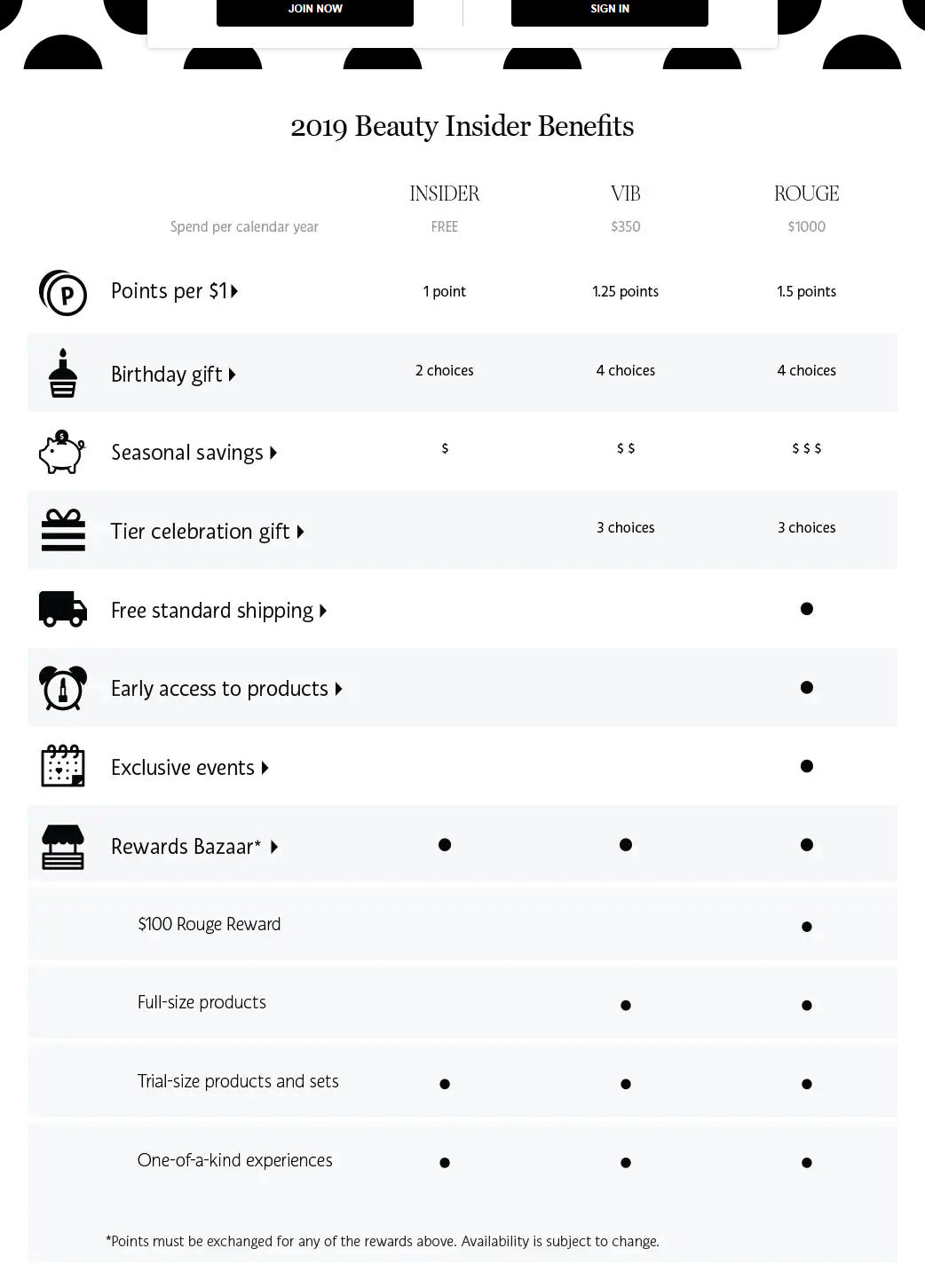
Someone who does it well is Sephora. If you look at the Sephora Beauty Insider program, it rewards dedicated beauty shoppers with more than discounts and free shipping; it has early access to products, exclusive events, access to like-minded beauty enthusiasts, and other extra frills. Customers are encouraged to buy more and stay on to reap the benefits tailored right for them.
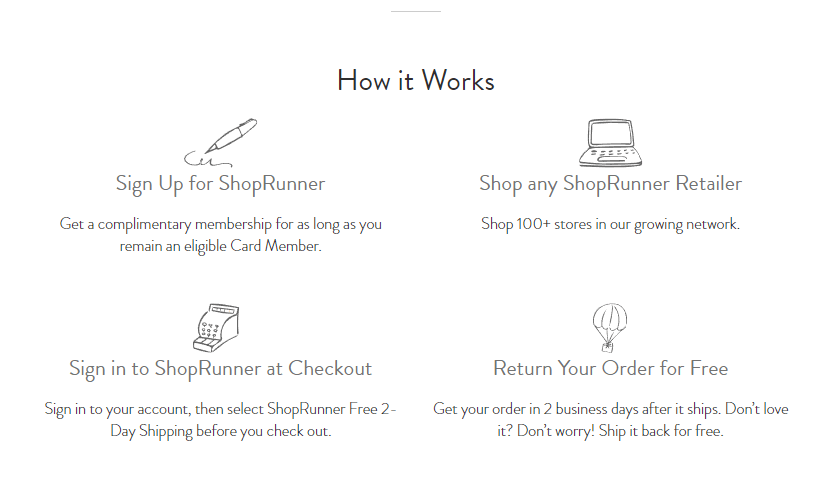
Another unique membership program is Shoprunner, which partners with high-end luxury retailers to provide free 2 day shipping for its members. The membership is currently free for customers, potentially charging the retailers for the express delivery service.
Pros:
The advantages of this shipping strategy are:
- Sellers can offer ‘free shipping’ while recovering the shipping costs from customers at the same time.
- Customer data acquired through loyalty programs can be used to drive other marketing campaigns and to design future products.
- Customer behavior data can help you improve your user experience by conducting different experiments on the same customers.
Cons:
A few things to keep in mind while offering loyalty programs:
- Sellers should be wary of customers using loopholes to extract the maximum value against their membership, such as multiple people using one account.
- The success of loyalty programs is difficult to assess over a short period, given the need for customer longevity.
17. Offer Free Shipping for a Limited Time Window
If you’re not yet set to offer free shipping all the time, free shipping for a limited time serves as a great marketing tool in many cases. The purpose of providing free shipping here is to encourage additional purchase and build a relationship with the customer for future business.
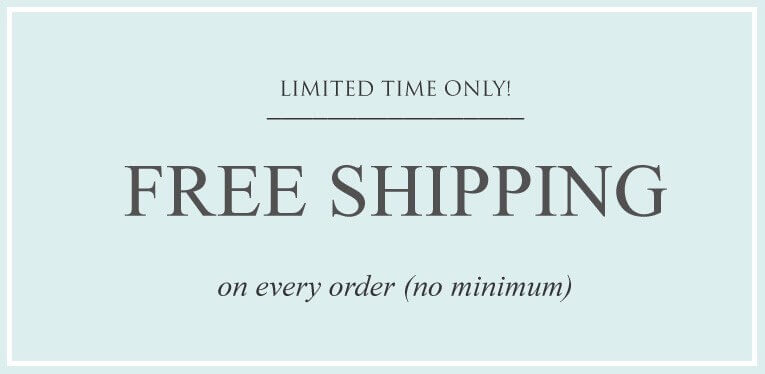
Very simply, you need to set a target of future incremental sales from customers who have used the free shipping promotion. The margins from incremental sales should cover the costs of shipping during the offer and help you assess the success of your campaign. Additionally, just acquiring more customers could increase brand awareness, which will attract new prospects organically in the future.
If you have a high engagement rate on your web store but low conversion rate, that means customers need a nudge to complete the checkout. Offering a limited-time free shipping offer will excite the prospective buyers and turn window shoppers into paying customers. Temporary free shipping can be an excellent investment to boost sales during slow periods. It is essential to be careful about frequency to not habituate the customers to free shipping.
You can be creative by offering a limited time offer through different shipping strategies:
- Offer free shipping on next purchase to customers only after checking out. This acts as a reward for shopping with you and encourages the customer to explore your catalog for future purchases.
- Offer customers free shipping when they share their purchases on social media or after writing a product review. Here, you are using free shipping to increase your exposure and potential sales via consumer generated content.
The broad idea is to invest in the shipping cost for a few orders to acquire more customers and get more future orders.
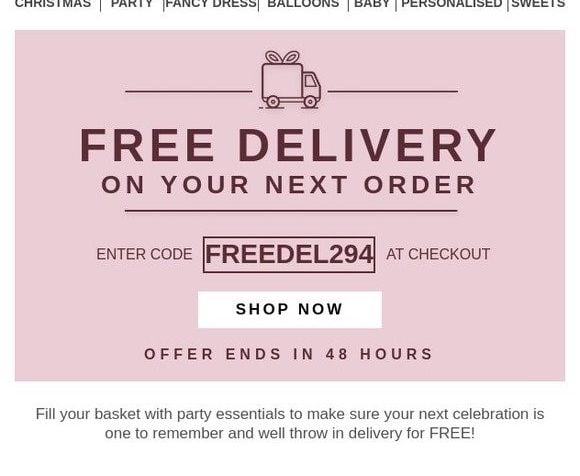
Pros:
- Limited time offers of free shipping require relatively fewer changes in order fulfillment operations.
- Free shipping promotions can be added on top of your existing discount promotions to make them more effective.
Cons:
- Running limited time offers frequently may accustom the customers to expect free shipping all the time.
- Free shipping promotions being so commonly available these days can get lost amongst the host of other promotions.
18. Offer Free Shipping at Peak Seasons of the Year
Free shipping is not a value creation strategy if you do not have enough sales to increase your bottom line with reduced unit margins. Therefore, offering free shipping during peak season could be a better idea. One, there is potential for more sales and two, you need to be competitive when everyone is offering some kind of promotion. Free shipping is cherry on the top of any other promotion.
Every business has a seasonality to it. Depending on your products, test out free shipping offers during different times of the year such as Christmas, Mother’s Day, Valentine’s Day, Amazon Prime Day and Back-to-School.
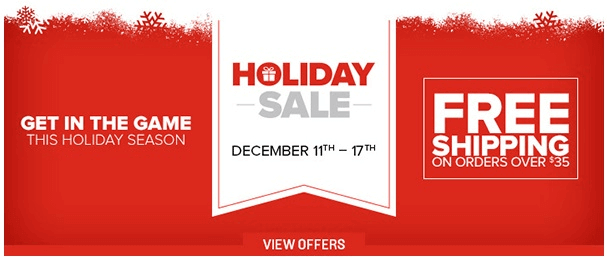
Third-party sellers on various marketplaces such as Amazon could also benefit from offering free shipping during their flagship sale day. Increased customer traffic on Amazon during Prime Day can work in your favor only if you can stand out. Even if you don’t offer free shipping all year round, temporarily offering free shipping could help you convert a larger share of the increased traffic to the site.
Best Buy has been offering free shipping to all customers during its peak holiday sales season. Target, on the other hand, offered expedited free shipping before Christmas on most of its items. The key was to increase sales during the peak season and get even bigger share of the pie than usual.
The objective of this shipping strategy is to increase profits by increasing gross sales at a lower margin, but be mindful of not losing money on every sale. Customer acquisition can be a secondary goal, but the primary purpose of this shopping lift should be to increase your overall profit. It’s possible that customer spending on your site during the off-peak season might not cover the promotional free shipping losses made during the peak season, so you may have to wait until the next year for a possible pay-off. Therefore, be selective about what products you offer with free shipping.
Pros:
- It is relatively safe to offer temporary free shipping as the increase in sales volume will guard against the downside in margins.
- This shipping strategy does not set unrealistic customer expectations of free shipping all year round.
Cons:
- Running peak season promotions to acquire customers at loss may create uncertainty of pay-off if the off-peak sales are lower than anticipated.
- It is a busy time for both carriers and online sellers. The sheer volume spike can cause delays when on-time delivery is crucial (e.g. gifts shouldn’t arrive a day or two after Christmas). Make sure you’re prepared to handle fulfilling this sales jump and not disappoint your customers.
19. Offer Free Shipping on Returns Only
Online shopping prominence has made returning products much more critical in the last few years. Customers care about the ability to return the item if they are not satisfied with it almost as much as free shipping. Hence, there is an opportunity to attract customers by offering free shipping on returns as a feature of shopping with you.
There are few categories, where the customer thinks about returns even before they have made the purchase. These are the products that conventionally require a trial. Anything in the fashion category, house décor, and jewelry fit into this.
When customers shop for clothes, they cannot be 100% certain of the fit or how they would look wearing the product. The risk is higher if returns are complicated (e.g., how to print the label, how to mail them, how much will it cost to ship, etc.). This creates a lot of hesitation for the customer to buy these things online. Free returns take the fear out of monetary loss from unsatisfactory purchases. For example, kurufootwear.com, an exclusively-online footwear-store, advertises free returns explicitly.
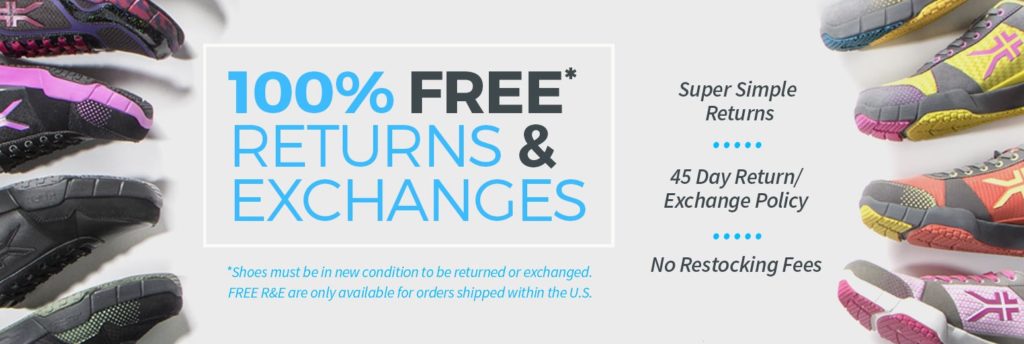
Free returns can become very costly for items that have high shipping costs such as a couch or television. Therefore think about what products are worth offering with free return shipping. Products that are light and small with good gross margins are good candidates as the reverse shipping costs won’t eat up all your profits. Expensive or high-end luxury products are prime examples of products that enjoy a good margin and hence excellent candidates for free return shipping.
Nevertheless, try to keep returns to a minimum by helping customers choose the right item in the first place. This can be done by having detailed product information section, multiple size charts, FAQs, and useful visualizations.
Besides making it free, make sure that the customer receives hassle-free service during the return process. This can be achieved by giving them clear instructions on the site or including a pre-paid return shipping label inside the original package itself.
Pros:
- By offering free shipping on Returns only, not all orders will incur the cost of additional shipping expense
- It attracts customers who are wary of shopping online altogether because of the fear of getting duped by product presentation.
Cons:
- A free returns policy can encourage unwanted consumer behavior such as wardrobing or ordering an item without serious intent to keep it.
- A free returns policy must be accompanied by investment in product visualization and additional product description to ensure minimum surprises to the customer.
20. Offer Free Shipping to First-Time Customers Only
Getting customers to try your products can be the biggest hurdle in growing your ecommerce business. Offering free shipping could be the nudge that customers need to buy from a new online seller. Such an offer makes sense for a retailer who is looking to broaden its base or acquire new customers.

It is a simple but effective shipping strategy. Many successful businesses, such as Postmates or Grubhub, have used it in the past to get the customer on board. Once the customers realizes the value of the service, they stay on to become regular paying users.
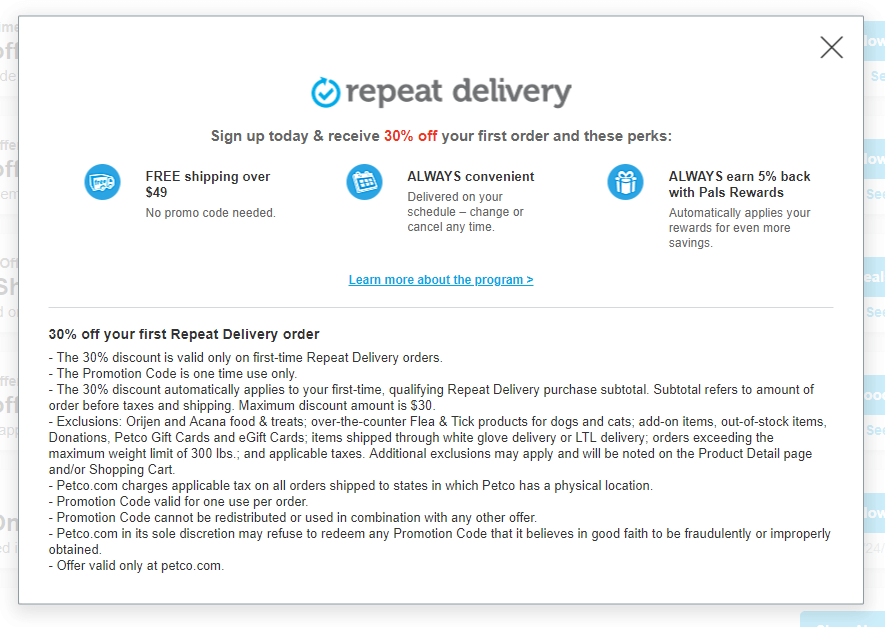
Petco.com offers a similar offer to first-time customers. They even doubled down on this shipping strategy by providing an additional discount on first purchase and free delivery on the first repeat order. This lays out the foundation for a long-term relationship and more orders from that customer in the future.
An existing ecommerce seller with a new product offering or a brand new online store, free shipping on the first order can get the product out into the hands of the customers. This is especially useful in consumable categories like pet food, coffee and vitamins where customers tend to order the products at routine frequency but are not sure if they are ready to commit to the product or the seller just yet. It can be considered as an online version of free sampling.
Pros:
- A way to get new products in the hands of the customers or for a new store to gain visibility in front of customers
- Paves the way to a long-term relationship when coupled with consumables/regularly purchased items
Cons:
- May be vulnerable to exploitation if not executed properly (e.g. multiple fake accounts)
- May not be enough to entice new customers depending on what competitors are offering and which season is the promotion
You can also see a quick video of this episode here.
Part 5 – Third-Party Logistics
Fast shipping is just as important as free shipping. Amazon has conditioned customers to expect 2-day shipping and is continuing to push one-day delivery as the norm. As a third-party seller, it can be costly and sometimes impossible to deliver on such expectation. Thankfully, several third-party logistics services help you relocate inventory to different parts of the country to fulfill customers in under two days. They provide services from inbound freight to final shipping.
In this section, we will focus on different models of third-party logistics (3PL) services:
21. Fulfilled by Amazon (FBA)
Fulfilled by Amazon (FBA) is a logistics service focused on products sold on Amazon marketplace by third-party sellers. FBA enables online sellers to reach their customers as fast as possible through warehouses across the nation, along with Amazon’s renowned customer-obsessed service. Also, items fulfilled by FBA are eligible for Amazon Prime two-day shipping, free shipping, besides other benefits.
FBA assumes all responsibility of fulfilling an order right from storage to handling returns. Along with basic order fulfillment services, it offers 24/7 customer service, and shipping costs are included in the FBA fees.
Amazon has more than 400 order fulfillment centers currently in the U.S. and uses pioneering technology in warehouse, order, and inventory management to reduce cost and increase speed and efficiency. It has continuously pushed the boundaries of fast shipping by utilizing its own last-mile delivery fleet and services.

Amazon charges two types of fees, – fulfillment fees and monthly storage fees. You can find the latest pricing on this page. For products sold on Amazon, pricing is one of the cheapest for third-party fulfillment service. However, if you operate a multichannel business, the fees are nearly double to fulfill an order originating outside of Amazon.com.
Pros:
- Most of the product fulfilled by FBA automatically qualify for Prime badge and more likely to get the buy box.
- Service fee includes deeply discounted shipping rates and world-class customer service available 24/7/365 to your buyers.
- Ecommerce Sellers get protection in terms of their ratings and reviews on Amazon in case of unsatisfactory deliveries due to issues in order fulfillment or shipping.
Cons:
- It is expensive for fulfilling orders from other sales channels due to higher fees and lack of custom branding on the package. Walmart has even prohibited its sellers from using FBA to fulfill orders received on Walmart.com.
- It is not suitable for heavy items as handling costs can be very high.
- Storage costs can add up quickly; therefore, seasonal or slow-moving items can incur high charges.
- Online retailers have no control over order fulfillment operations and must keep up with strict ever-changing guidelines from Amazon.
22. Traditional 3PLs
FedEx Fulfillment, UPS Supply chain solution, and C.H. Robinson are some examples of 3PL providers that also provide end-to-end solutions for ecommerce businesses from inbound freight to white-glove last-mile delivery and returns management. They have an extensive network of distribution centers around the world with infrastructure to support large-scale logistics.
For example, FedEx Fulfillment uses conventional logistics infrastructure to offer 3PL solutions to brands and retailers. It combines FedEx Freight, FedEx Fulfillment, and FedEx Shipping all rolled into one to provide 2-day delivery across the nation. They offer a complete solution, including inbound freight, storage, pick-and-pack, shipping, and returns.
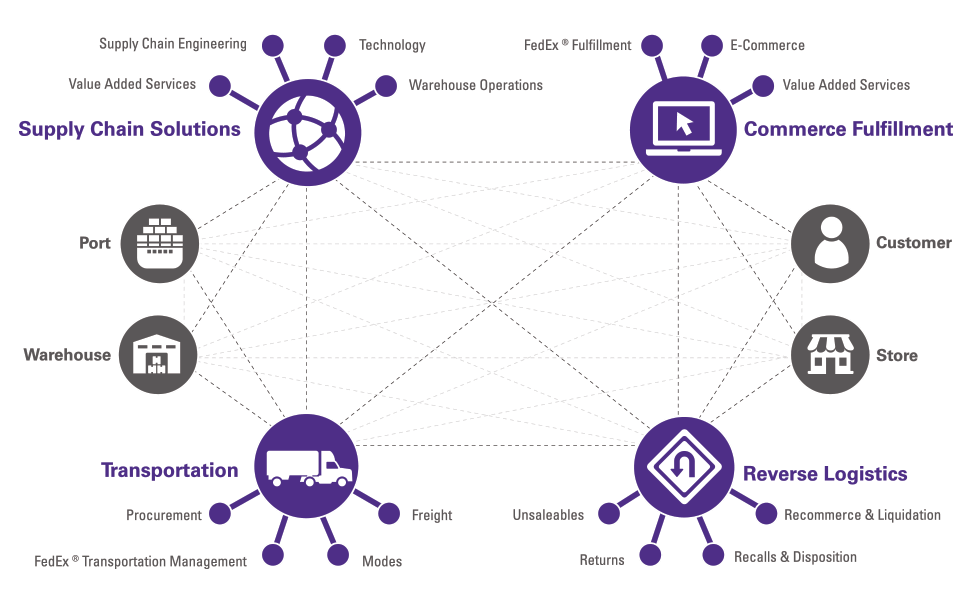
Traditional 3PLs offer custom pricing to customers based on volume. One can get better pricing with higher volume. All your operations are coordinated by a dedicated account manager who works directly with you. The order fulfillment fees are standard depending on the size of your units and the packaging required, but you may qualify for discounted shipping rates.
Pros:
- Discounted pricing on shipping and freight for large volumes.
- An end-to-end solution with everything from in-bound freight to last-mile delivery.
- Ecommerce sellers can service orders originating at different marketplaces and support multi-channel sales through easy integration with popular online platforms like Magento, Shopify, and BigCommerce.
- Some 3PL providers have extensive networks that cover even international markets
- Support for reverse logistics from processing customer refunds to the liquidation of returned inventory
Cons:
- It is expensive for fulfilling orders from other sales channels due to higher fees and lack of custom branding on the package. Walmart has even prohibited its online sellers from using FBA to fulfill orders received on Walmart.com.
- It is not suitable for heavy items as handling costs can be very high.
- Storage costs can add up quickly; therefore, seasonal or slow-moving items can incur high charges.
- Ecommerce sellers have no control over order fulfillment operations and must keep up with strict ever-changing guidelines from Amazon.
23. One-Stop Outsourced Service Partner
Whitebox and Cpg.io are examples of outsourced third-party solutions that go beyond the scope of logistics and provide an all-inclusive solution for online sellers looking to outsource their entire ecommerce operation.
Whitebox works on top of Amazon FBA to further enhance the retailer’s brand by offering product listing creation and market research. Cpg.io provides support for multiple marketplaces, including Amazon, Walmart, and eBay.
They set up the seller account and support all the day-to-day tasks from product listing to inventory replenishment. It includes quality control, kitting, warehousing, order fulfillment, optimizing product listings, and managing reverse logistics.
Optimization of listing includes managing stock quantities, keyword research, and product visualizations. They also help you select and run appropriate marketing campaigns for your products.
You can optionally choose to list your products on marketplaces under their Seller account, so in essence, they become the seller of record. They act as a partner who takes care of all the operations and takes a cut in profits while you are responsible for just the availability of the product itself. You typically get paid at the end of each month after deducting their fees. They typically charge an onboarding fee and offer a la carte pricing depending on the services you require.
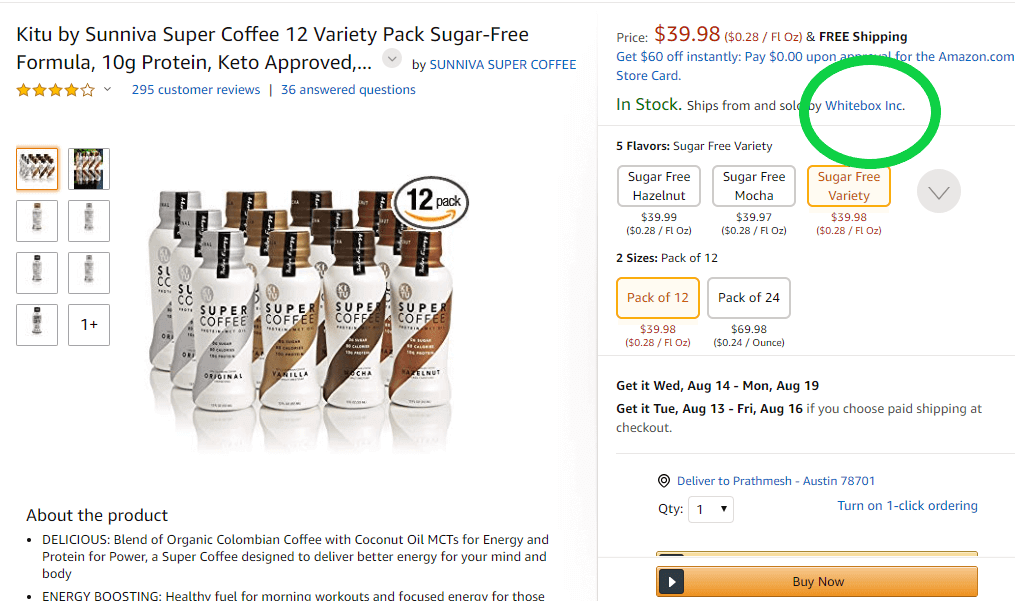
Pros:
- Their scope of services goes beyond just order fulfillment; this may be an attractive choice for online retailers with little or no experience or ones not looking to actively manage their ecommerce operations.
- Products can get the ‘Prime’ badge without the hassles of managing FBA requirements directly yourself.
- Sellers benefit from the partner’s experience and know-how in implementing best practices in listing optimization and order fulfillment from the get-go.
Cons:
- They do not cover the freight logistics for inbound shipping, requiring you to hire another service provider for that.
- Ecommerce sellers have less freedom to implement their own ideas on marketing their products on the marketplaces.
- Outsourcing nearly all your operations will cost you more vs. other operating models.
24. On-Demand Warehousing
On-demand warehousing is a relatively new concept that connects online sellers with multiple warehouses and 3PLs across the country. Solutions such as Flexe, Flowspace, and Ware2Go utilize a two-sided platform model akin to Uber or Airbnb. On the supply side, warehouse operators and 3PLs list their unused space, and on the demand side, sellers can rent warehouse space and purchase order fulfillment services.
The platform takes care of all the support and additional services needed to effectively run an order fulfillment operation. This includes all the typical functions such as receiving inbound shipments, storage, pick-and-pack, and outbound shipping using the right carrier; but through multiple facilities in distributed geography instead of just one.
For online sellers, these platforms provide an order and inventory management system that allows them to manage their product catalog and aids them to distribute their inventory while keeping track of order fulfillment. This includes visibility into distribution, tracking inventory levels, tracking fulfillment, and replenishments.
For Warehouses, these platforms inspect and certify the available space and the order fulfillment support provided by these firms. Through a software interface, warehouses monitor and manage the inventory sent to them via the platform.
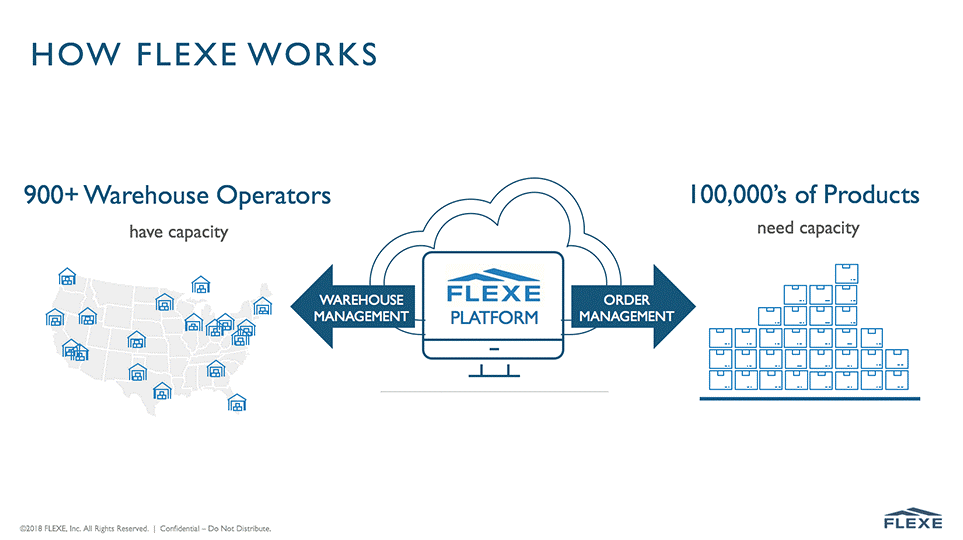
The advantage of using on-demand warehousing is the ability to get distributed warehousing without committing to a capacity long-term. You can change your mind about how much space you need on short notice and scale up or down as needed. It is both useful for online retailers in the growth stage and who have uncertain demands.
Pros:
- Online sellers only pay for warehouse space they need without the long term commitment.
- The storage fees may be cheaper than conventional 3PL models because warehouses on the platform mostly list their unused space.
- Sellers get access to many more facilities than those available via a typical 3PL.
Cons:
- The space availability in a region is subject to the availability of warehouse providers on the platform.
- The service level beyond a minimum standard (guaranteed by the platform) may vary depending on the warehouse provider.
- Not always a solution for smaller ecommerce sellers. Some platforms require a minimum number of orders per month.
- Is more expensive than a traditional 3PL because both the warehouse and the platform needs to charge and make money in order to make this service available to sellers.
25. Emerging 3PL Solutions for Sellers
There are a few models on the market that specialize in catering to new online sellers and emerging brands. They do not provide a one-stop solution but help out in costly order fulfillment through services and pricing for new sellers. Let’s talk about two interesting players in the limelight: ShipBob and Deliverr.
ShipBob offers a package of 3PL services designed for newer small businesses. Online sellers can do batch-fulfillment with ShipBob in case of a seasonal offering, a crowdfunding campaign or subscriptions, and continuity programs. It is a start-up friendly order fulfillment service with a minimum requirement of only 100 orders per month. It also offers standard fulfillment services including support for inbound freight, distributed warehousing and specialty kitting for private brands.
Deliverr focuses solely on fast deliveries through a lean order fulfillment network. Deliverr leases unutilized spaces from different warehouses throughout the country. Once you sign up with Deliverr, they estimate future sales geographically with their proprietary algorithm and then distribute inventory only to regions with meaningful future sales. They don’t offer other services such as freight or returns. This enables them to offer cost-effective fast shipping for orders originating at multiple marketplaces.
Pros:
- They enable distributed order fulfillment for new online sellers without large minimum volumes.
- They are a cost-effective solution for sellers who require assistance with fast order fulfillment but are adept at handling sourcing and marketing.
Cons:
- The quality of service provided by the underlying facility could be inconsistent since they rely on third-party infrastructure and their operational maturity.
- They do not provide order fulfillment solutions for international markets or personalized branding and unboxing experience.
- Ecommerce sellers may need to manage several other operations such as freight and returns.
You can also see a quick video of this episode here.
Part 6 – Special Carrier Services
We have covered a variety of methods to ship, and increase profitability while doing so. However, there are some more methods to ship profitably if your online business has certain features such as concentrated sales in a region or an international customer base.
Here, we cover 5 special carrier services that may well just be the right fit for you:
26. Use Zone Skipping for High Volume Zones
Zone skipping is a practice of consolidating orders and shipping them together to a destination region. From there on, the parcels can be shipped individually within the destination region. The shipping cost is often calculated by the number of regions or ‘zones’ a package travels through to reach the destination. Through zone skipping, the parcel is injected into the carrier’s network directly into the destination zone. Hence, the term Zone-Skipping.
This is ideal for online sellers with a large volume of sales within a region. If you have close to a truckload of orders from a zone every day, zone skipping is for you. Your objective should be to get your orders as close to the destination as possible, from where the shipping carrier can pick-up and deliver each package to the final destination.
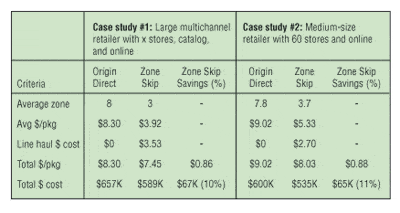
For example, if you are based out of Detroit (Zone 1) and have a considerable volume of orders coming in from southern California (Zone 8). If you ship all your orders directly, you will have to pay for high shipping rates for Zone 8. Instead, with zone skipping, you can bundle all your orders from California every couple of days and send them to Southern California by a truck. Once in California, it can be picked up by the shipping carrier and shipped within the Zone at lower rates. You end up saving big because paying for bulk transportation is far cheaper than the difference between zone 8 and zone 1 shipping rates.
Here is a snapshot of how zone skipping saved money for two online merchants:
USPS Parcel Select is a great complementary service to zone skipping. Under Parcel Select, sellers are expected to drop their packages in bulk at a postal facility as close to the destination as possible. Not only, do they save on zone-skipping, but Parcel Select also offers an additional discount for dropping off large orders at once. In fact, Parcel Select is used by UPS and FedEx too as part of their hybrid shipping services, mentioned in the third-party logistics section of our guide.
Pros:
- Online retailers can save more than 10% on their shipping costs which can be substantial for many orders
- Zone skipping enables sellers to access additional discounts through Parcel Select.
Cons:
- Online sellers must arrange for transportation of parcels in bulk to the destination zone.
- It is slower than Ground Shipping if the volumes are not large enough to fill a truck in a day.
27. Ship Directly from Overseas Using the Global Mail Program
Sourcing from overseas can seem like a costly affair because of the obvious reasons. But there is an international mail program that makes it incredibly inexpensive to ship from some countries, including China.
Under a program called ePacket, ecommerce sellers can ship products that weigh less than 4.4 pounds for a low rate. It is governed by a century-old treaty called Universal Postal Union (UPU) between major nations wherein postal services have agreed to deliver mail coming from other countries for a fee called terminal fee. Now, this fee is based on how ‘developed’ a country is. Say Chinese postal services can charge higher for deliveries from Western countries as western countries are more developed. Vice versa, USPS can only charge very little for the post coming from China. This has made it cheaper to deliver from China to Texas, compared to New York to Texas.
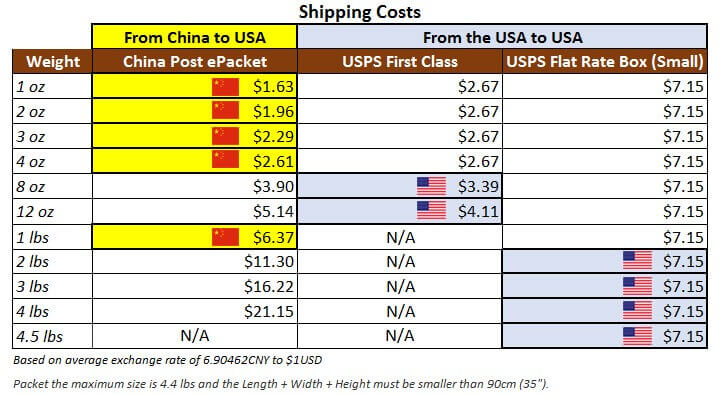
Wish.com bases its whole business model on Chinese sellers using ePacket to deliver their products at extremely low prices. As a seller, you can also take advantage of this. Start with establishing a trusted supplier of quality items in China. However, it is challenging to locate a reliable supplier due to physical and cultural distance. After overcoming this hurdle, you need to think about managing returns within the country as shipping back the product will be a lot more expensive.
It must be noted that this program has come under a lot of scrutiny under the Trump administration. The White House wants to put an end to low-cost shipping from overseas, a move widely supported among U.S. e-commerce sellers. USPS has also warned shippers that they may no longer be eligible for discounted rates if the US leaves the postal union, pending negotiations with the other members to form new bilateral and multilateral agreements. Previously negotiated rates for international shipping may be null on Oct. 1, 2019 — creating even more uncertainty for cross border e-commerce going into the peak season.
Pros:
- Sellers don’t have to set up a warehouse in the US if your supplier can drop ship directly at such low costs.
- Sellers can compete with the Chinese sellers on prices in certain categories (weighing less than 4.4 pounds).
Cons:
- The deliveries can take up to 20 days, making it suitable for certain categories only.
- ePacket is valid for items weighing less than 4.4 pounds.
- Managing and reselling returns can become a complex operation.
- This program may be short-lived and replaced with higher rates as the U.S. government renegotiates its contracts under the United Postal Union (UPU)
28. Use International Freight Forwarders to Fulfill International Orders
Shipping international from the US can be a costly affair. Besides, international shipping can be an operational headache too. There are several things to consider. You need enough manpower and time to manage different aspects of international shipping.
International Freight Forwarding services carry out the logistics operations on behalf of a firm. These generally involve, as the name suggests, large orders. But with the increase in ecommerce, a lot of freight forwarding agencies offer services tailored to ecommerce sellers.
Freight forwarders provide less-than-container load (LCL) services for ecommerce sellers. They bundle your parcels with other parcels to fill pallets and containers, which are then delivered to your destination country via the conventional freight network. At the destination, the last mile delivery is done by the local postal service in the destination country.
This end-to-end process is taken care of by the freight forwarder. Online sellers enjoy savings since they get freight discount for parcel shipping and have to deal with their freight forwarder only. Freight Forwarders also provide support for calculating real-time duties, taxes, and other governmental fees to present itemized final prices to customers as well as costs to sellers before the sale is made.
In some cases, if you have an order fulfillment provider like Amazon FBA in the destination country, freight forwarder ensures that your items reach the fulfillment provider’s warehouses.
A good example of such a service is DHL ecommerce (formerly Global Mail) which provides a solution tailored for online sellers.
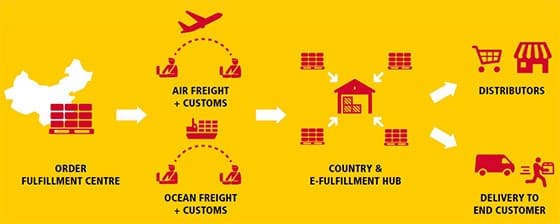
Pros:
- Sellers get discounted freight rates along with simplified cross-border charges.
- Sellers maintains control over the checkout process for international customers including pricing and marketing.
Cons:
- It is hard to monitor and audit cross-border fees if there is no transparency from Freight Forwarder.
- The delivery time can be incredibly long, making it unsuitable for some product categories.
29. Selling Internationally through Full-Service Cross-Border Solutions
While delivering domestically can be taken care of using other shipping strategies we’ve discussed in our guide, selling and delivering to customers in other countries is a whole other ball game.
Aside from accurately calculating shipping charges and various import fees, there are a few other things that an online seller needs to do. To avoid surprises, your customer must understand your product’s pricing and the different tariffs included in the final landed cost. Additionally, having familiar payment options at checkout would reduce hesitancy, for example, allowing payment via China Union Pay, WeChat, or Alipay.
Thankfully there are cross-border solutions such as Pitney Bowes’ BorderFree and International Checkout that provide a comprehensive solution for selling to an international customer. An end-to-end solution offering typically includes:
- Localization of your product content and checkout pages in locale-specific language, UI, and currency.
- Calculation of duties, taxes, and import fees for transparent final pricing to customers before the order is placed.
- Presenting and processing country-specific payment options.
- Efficient international order fulfillment using freight forwarders and other service providers.
The following checkout page example of an online store that uses Borderfree shows personalization to a Chinese customer buying from a seller located in Australia.
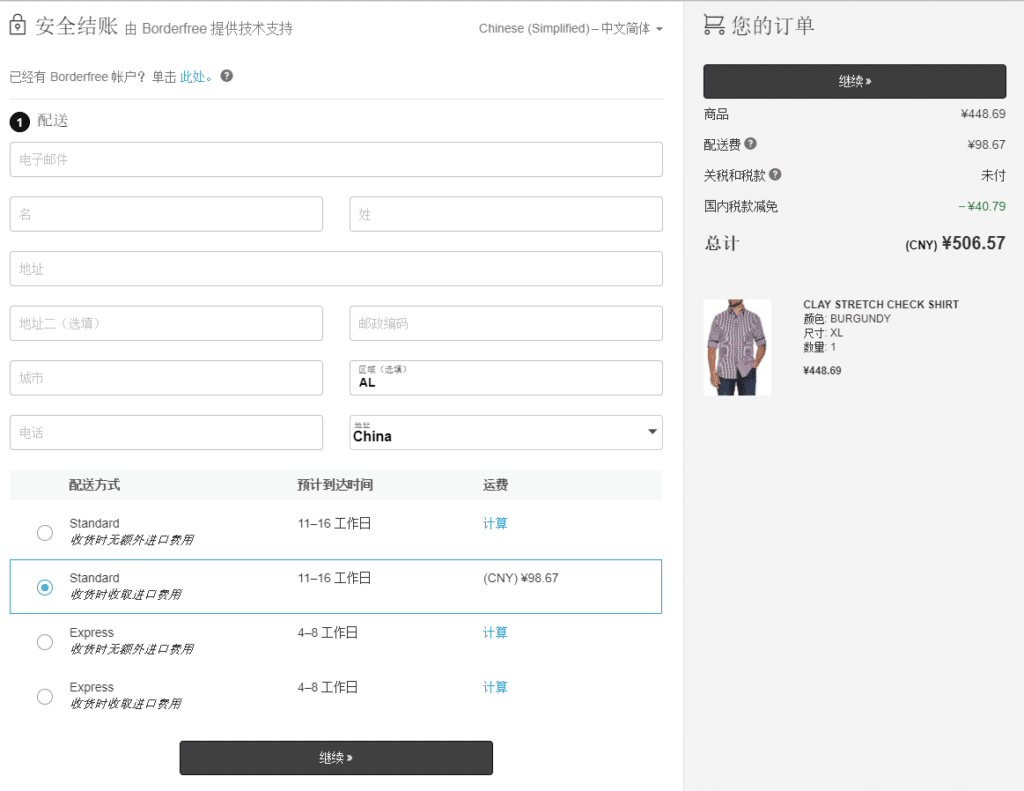
Pros:
- Online sellers can increase their market reach to include international customers without having to deal with all the operational complexities.
- Sellers save on additional costs for website development that includes local payments and locale-specific content and customer service for international customers.
Cons:
- Limited control over customer experience for international customers due to complete dependence on a third-party service provider.
- The program may not be profitable, at least in the beginning, if your products do not have sufficient demand in the overseas market.
30. Amazon Logistics
Amazon Logistics is newest last-mile shipping service meant to complement and partially replace existing national providers like UPS, USPS, and FedEx. It started by servicing Fulfilled by Amazon (FBA) orders, but of late, high performing retailers without FBA have also been invited to use Amazon Logistics at low teaser rates. If you are a top-rated seller on Amazon and haven’t got any such invitation, you should reach out to your Amazon contact and try to make your case for it.
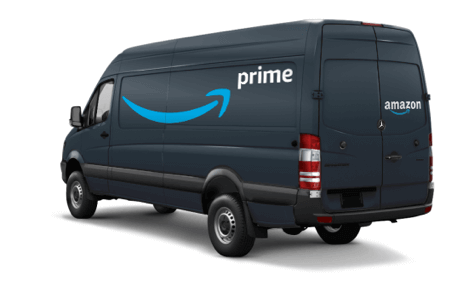
Amazon Logistics offers a range of services for Amazon sellers from 7-day to same-day delivery. It provides the technology needed for drivers to handle deliveries. Amazon Logistics uses Delivery Service Partner (DSP’s), freelance partners delivering on behalf of Amazon. This way, the dependence on traditional shipping carriers is eliminated, and Amazon can offer fast deliveries at low costs. This program is still new, and due to its reliance on freelancers, sellers have had uneven experience in deliveries through DSP’s.
Amazon logistics can be even cheaper than the discounted shipping rates that Amazon offers to merchants using its FBA program. With total control over operations and contracted workforce, Amazon can run an efficient and lean operation and pass on incredible savings to its participating merchants.
Pros:
- It allows retailers to take advantage of Amazon Lockers and potentially other logistic innovations from Amazon.
- Sellers can enjoy expedited shipping such as same-day delivery and two-day delivery with rates lower than popular carriers.
Cons:
- The delivery experience for the end customer may vary depending on the logistics partner as they are independent contractors as opposed to full-time Amazon employees.
- Sellers cannot choose or avoid a DSP based on their past experience.
You can also see a quick video of this episode here.
Part 7 – Supply Chain Options
There are many ways an online seller can orchestrate the flow of products from manufacturers to consumers. With big competitors operating with best practices in supply chain management, it’s almost imperative for you to continue improving yours to stay competitive. Any cost reduction from an optimal supply chain can alleviate the costs of offering free shipping to end customers.
Points 31 through 35 talk about ecommerce-friendly supply chain options that will help you fulfill your orders profitably:
31. Minimize Delivery Time with Ship from Store
If you already have a brick-and-mortar presence, your stores can be turned into mini-order fulfillment centers. Through this method, people working in stores will be the one picking, packing, and shipping your orders. Having more locations to send from can cut the distance your package needs to travel.
Leading brick and mortar retailers such as Target have adopted the shipping strategy to fulfill orders received on its site. A well-established network throughout major cities reduces costs & delivery time by shipping from the nearest store. Such a feat is typically assisted by an Order Management System or OMS that can analyze inventory levels and delivery-time-to-customer to determine which warehouse or shop is most appropriate to ship from.
If you don’t have your own stores yet, there’s a possibility to partner with stores that carry your product. Alternatively, partner with a brick and mortar store and list their SKU’s on your store. You can take care of online visibility and sales while the store fulfills the orders. However, because conventional stores are not designed to fulfill online sales, employees need to be trained to handle e-commerce order fulfillment.
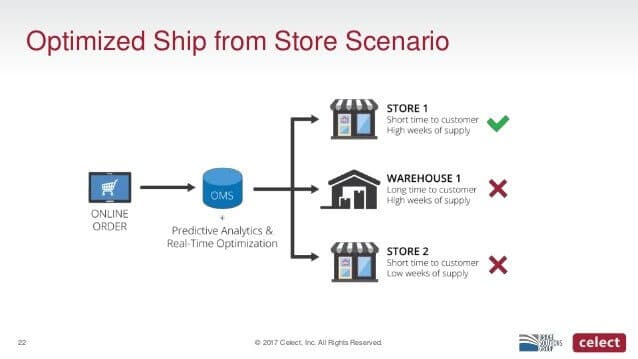
Pros:
- Brick and mortar stores can increase their sales by adding an additional channel of sales.
- Online sellers can reduce costs and increase delivery times by shipping from stores closest to the customers.
- Shared inventory reduces safety stock in case of split inventory.
Cons:
- It requires an integrated inventory management software to get real-time visibility and requirements for offline and online operation.
- The physical spaces in stores need to be redesigned and retooled to enable packaging and shipping online orders.
- Employees need to be trained to fulfill online orders.
32. Minimize Inventory Storage Through Just in Time
Just-in-Time inventory Stocking (JIT) is a common inventory management technique and a lean methodology to increase efficiency. A successful example is Zara with its “mind-spinningly supersonic” supply chain. Zara operates in an industry where inventory “spoils” quickly so they commit less than a quarter of a season’s line and produces about half of its line at the start of the season. The remaining? They were designed and produced during the season. Zara watches for popular styles and puts new designs like it in stores throughout the season while it’s still popular. With JIT, Zara improved its cash flow by reducing low-demand inventory.
Today online sellers can quickly gather and process historical sales data to make better demand predictions. As a buffer, some safety stock is still needed but sellers won’t have to dedicate ample space for storage. With proper planning, deliveries may not be fast, but you can provide a guaranteed delivery date to all customers.
Another application of JIT is cutting storage costs at 3PLs such as Fulfilled by Amazon. FBA is generally an excellent option, but only if the seller can handle the storage costs. By estimating their sales via FBA, sellers can ship items regularly to FBA warehouse in quantities that will sell immediately. The remaining items can be stored in an inexpensive warehouse or own facility.
Pros:
- Lower inventory holding costs leading from smaller storage space needed and less deadstock
- Free up cash flow, money not used to stockpile inventory can be reinvested elsewhere
Cons:
- Very accurate estimation of demand is needed to minimize stockouts.
- Buying inventory all the time makes you more sensitive price shocks, margins will slump if prices suddenly go up
33. Buy Online Pick up In Store
This is not a strictly an option to improve ‘Shipping’ as in delivering to customer but can help you in satisfying the customer need at a low cost. Buy Online Pick-up in Store or BOPIS enables customer to pick-up their items from a physical location nearby either at your store. The key here is eliminating shipping altogether by getting the customer to pick up their order.
Customers expect free and fast shipping and in some categories such as grocery, healthcare products and some household items, fast shipping is a priority over free shipping. In such a case, BOPIS bypasses the shipping process, cutting delivery from days to mere hours. More so, it can be a differentiator between you and the competitor, increasing your total sales. To minimize additional staffing needs and wait times, self-service package lockers can be installed. Prepared orders are delivered to a locker in your store that customers can open via an app or one-time password.
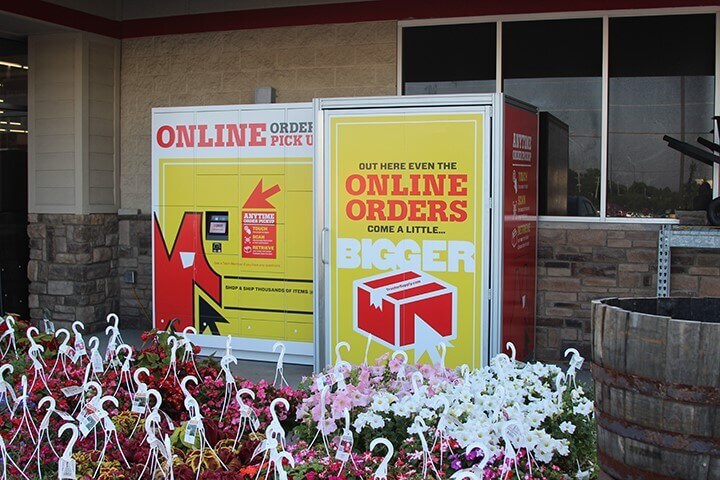
Pros:
- Online retailers can eliminate their last mile shipping costs and returns cost.
- The store pick-up can be used to drive more traffic to a retail location.
- The parcels are more securely delivered to the end customer without the risk of theft from doorstep.
Cons:
- Customers can get frustrated and dissatisfied if the pick-up is not convenient or involves waiting in line.
- BOPIS needs dedicated space for customers to pick up, some investment may be needed.
- BOPIS requires training and staff time to prepare orders
34. Zero Inventory Through Dropshipping
Dropshipping is a popular order fulfillment method used by many online sellers. Dropshipping sellers don’t stock up the items in their warehouse, effectively making it a zero-inventory business. Whenever an order is placed on their online store, the seller purchases the item from a third-party (such as a wholesale supplier) and has it directly shipped to the customer. Sellers don’t handle or even see the product in the whole process.
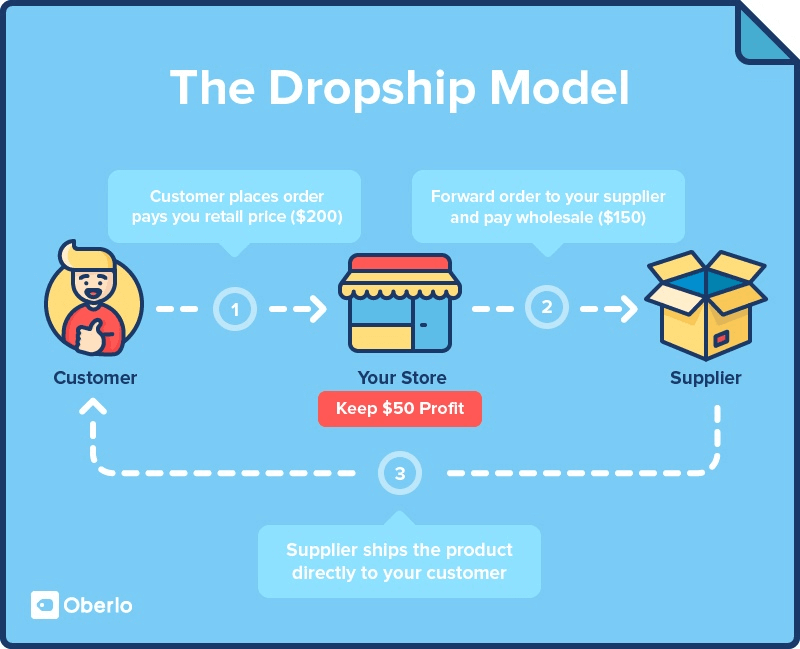
Dropshipping has a host of advantages as the online seller does not require startup capital, a warehouse or expertise in order fulfillment. However, the seller must contend with low margins and no control over fulfillment. Therefore, drop shipping should be pursued by sellers who intend to focus on building a diverse and creative product portfolio and concentrate on marketing to get the maximum sales.
Under the drop shipping model, the suppliers assume the risk of unsold inventory and cost of packaging and shipping. Even though you end up with lower margins, it allows you to offer free shipping while concentrating on improving your sales without worrying about fulfillment.
Pros:
- All order fulfillment operations from including shipping and returns are handled by the supplier.
- Less capital is required to start the business as the seller does not need to hold inventory to sell.
- Operating costs are also lower since there is no need for the warehouse or fulfillment facilities.
- Because of lower costs and low requirement of infrastructure, it is easier to start an online business with drop shipping.
- It makes it easier to switch product in and out of product portfolio and list many SKU’s.
Cons:
- The margins are very low as it is a competitive space. Since it is easier to start, many online sellers are present in the space with very low prices.
- Dropshipping is frowned upon by leading marketplaces such as Amazon and may incur suspension or penalty.
- The order fulfillment can be unreliable as you are not always aware of the inventory in stock at suppliers.
- Order fulfillment quality can vary as the suppliers have different priorities to yours depending on the size of your business.
35. Streamlining Your Supply Chain
We discussed some tactical shipping strategies such as JIT inventory and store deliveries. And we know supply chain, in general, is not an easy puzzle to crack. Whether you’re a veteran on the space or just starting out, it is always good to step back and reassess your supply chain for improvements.
However, ecommerce lags behind the brick-and-mortar stores inefficient supply chain management. Due to high growth in the past few years, online sellers have not realized the need to examine and solve inefficiencies. Looking for purposeful improvements in the supply chain can help you improve your cost structure and allow you to offer free shipping.
Here are a few high-level recommendations to streamline your supply chain:
- Optimize Sourcing: When you start out your online store, you go with the easiest option to start sourcing your items. As you scale and increase your bargaining power, you should look beyond the current sourcing and look for alternative suppliers that align with your selling strategy, which can occupy any position in the spectrum of cost leader or high differentiator. You should also consider talking directly with manufacturers in case you are dealing with aggregators currently.
- Optimize Order Fulfillment Location: E-commerce allows businesses to operate from anywhere simply with an internet connection. But as you scale, the inbound and outbound shipping becomes a significant cost as already discussed. Being closer to the customer can save you money and delight customers with faster shipping. On the other hand, being closer to vendors will help you reduce lead time and inbound costs. Both of these factors should be considered in deciding the optimal fulfillment center location. In addition, some locations also enjoy cheaper labor costs and government incentives.
- Reduce Inventory: As an ecommerce business grows, the common reaction is to increase warehousing facility and inventory size to meet the customer demand. But inventory is a cost trap and increasing inventory should be avoided as much as possible. Explore options such as reducing lead time from suppliers and getting rid of slow-moving inventory. Drastic measures such as liquidation and promotional sale of obsolete items should be standard practices in an industry with dynamic SKU’s.
- Consider Costs of Splitting Inventory: Distributed warehousing seems to be a mainstream solution for satisfying the customer expectation of fast shipping. However, the costs of splitting inventory are often overlooked. Multiple distribution centers require more labor as there is identical personnel needed at every center. Even when going with a 3PL service such as FBA, the cost of additional stock has to be considered. According to square root law of safety stock, splitting inventory increases safety stock required which in turn will increase your storage costs. There are indirect costs too. Online sellers lose the opportunity to learn and grow their own order fulfillment operation and become dependent on 3PL.
- Multi-Channel Sales: it is a good practice for retailers as many studies have shown the advantage of selling through multichannel is huge. You reach more customers and the topline sales growth increases. This is not different from the conventional brand offering their product through the flagship store, departmental stores, and specialty stores. In a similar vein, the online world has different channel dominated by different demographics of consumers. For example, Gen Z is more likely to shop via social channels through influencer marketing while millennials prefer comparing different marketplaces and stores.
You can also see a quick video of this episode here.
Part 8 – Returns Optimization
Returns can quickly become a major cost center if not appropriately handled. Higher returns mean higher shipping costs overall, thus offering free shipping becomes even more expensive. As mentioned earlier in the post, 95% of online customers will prefer an online store with a free return policy. That makes free returns an indispensable tool to stand out against the competition.
Points 36 through 40 talk about five ways to optimize returns in order to cut down it’s costs and increase profitability:
36. Eliminate the Root Cause for Your Returns
Prevention is the best medicine; our best-case scenario is for customers to have no reason to return products at all. Before we go on enhancing returns efficiency, let’s look at what we can do to prevent returns. There are three major preventable reasons why customers return a product (1) the product doesn’t match their expectations when buying, (2) they don’t like the product right away but they still might in time, and (3) they bought the product by mistake.
First, mismatched expectations. What customers see in the product page needs to be precise. Product descriptions should be elaborate and always have a detailed specifications section, mainly because different customers value different features.
There is more than one way to populate a good product page, below is an example from SoloStove.
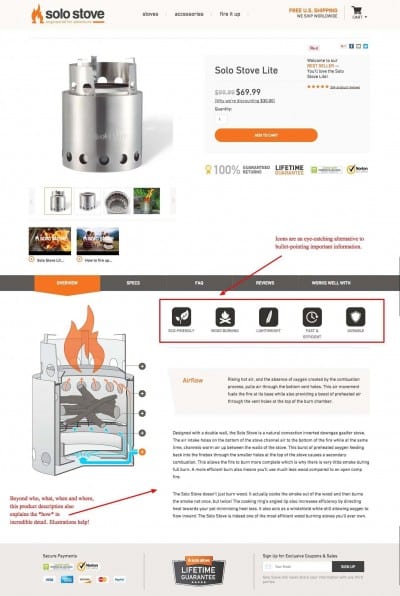
Visualization is important to convey the real product value. Add multiple photos from all relevant angles and if possible, a video too. It’s a more realistic depiction of the product in action. With the new development in AR and VR, few apps also allow customers to try their products virtually. Amazon is developing a virtual changing room, where you can try outfits on your virtual avatars. Warby Parker has used similar technology for their website. There are third-party applications which let customers try on products virtually from different online stores.
Having multiple helpful and fair reviews of your product is also essential. This adds to the transparency of your limitations and will prevent customers from surprises. Having numerous honest reviews with photos adds to the credibility of your product. Although only a handful of customers are willing to leave reviews, it’s a worthwhile effort to ask for one.
Second, not liking the product right away. Some products like home decor may take some getting used to and, you should try increasing the return window for these products. As opposed to increasing the returns, you will see a decrease due to this policy. It takes away pressure from customers to return as soon as possible. Going further, longer the product stays with the customer, more attached the customer becomes to the product, something economists call endowment effect.
Having support available for customers to ask questions would also reduce preventable returns. Some products like furniture require some assembly, and sometimes customers get confused. At that peak frustration point, customers will then return the product. Having a customer service line either from the manufacturer or through you can defuse the situation before returns happen.
Lastly, buying things by mistake. In the event of a mistake during check out, give customers the option to cancel their order within a short period after the order. So customers can reorder the correct item before fulfillment begins. This means it gets corrected before it costs you money for fulfilling the order, paying returns, and restocking.
It all boils down to having a killer product page. Building it is an interactive process, and it is important to understand why returns happen, so you can take the right steps towards improving your product page.
Pros:
- Stop returns before you incur fulfillment and return costs
- Successfully preventing returns also mean more satisfied customers
- Better product page helps increase the perceived quality of your online store.
Cons:
- There’s only so much visualizations and descriptions can do
- Being proactive with customer needs will prevent returns but would take time and money (if you decide to make a support team)
- Not as applicable to products that rely on touch-and-feel or try-on to convey its characteristics.
- It may require investment in professional photography and videography.
37. Offer Local In-store Returns to Save on Shipping and Drive Traffic
Now that you’ve finished dealing with the main reasons for product returns, it’s time to look into making returns more efficient and profitable. Offering returns to the store has two significant benefits. First, you (or the customer) won’t need to pay for return shipping. Second, it opens up the opportunity for more sales and makes up for restocking fees. Returning at a store is easier for customers who dislike the hassle of repackaging and shipping the product back to the seller. As long as customers don’t mind going to a store, it’s also faster for smaller issues such as a T-shirt size exchange.
A UPS survey found that more than two-thirds of customers who came to return at a physical store ended up buying something else. So even if a customer is not interested in the product anymore, there’s an opportunity to upsell other items in-store. You can also enhance that conversion with coupons offering discounts for customers coming for returns. For example, Kohl’s gives anyone returning Amazon products at their store a 25% off coupon that’s valid for 7 days. The pilot program has been successful for both parties and approved for a nationwide roll-out.
Pros:
- No return shipping fees needed by either party. Stores can pool restocked products into one bulk shipment to the warehouse vs. a myriad of small boxes.
- In-store returns reduce the hassle of repackaging and shipping unwanted products.
- It is an opportunity to retain a dissatisfied customer by offering an instant exchange, upsell, or store credit to buy more stuff, recovering the lost sale.
Cons:
- Partnering with stores that don’t sell your products may result in cannibalization.
- Impractical for customers located far away from the designated return stores.
- Stores would need to be able to restock inventory and ship back to warehouse if needed.
38. Use Returns Consolidator Services to Reduce Logistic Complexity
If you sell internationally, returns can be a massive logistical headache. Not only is it expensive and complicated with different carriers, but it also includes dealing with border customs. Moreover, if you are selling on marketplaces such as Amazon, you are required to offer local return addresses in countries you’re selling to and free return services.
However, international returns can be very pricy through carriers or forwarders or FBA. Some solutions exclusively handle international returns such as InterCultural Elements, or Salessupply, or ReBOUND. They pool product returns to cut down return shipping costs. These services collect returned items from multiple sellers in one country (e.g., all returns from your customers in Spain) into one warehouse and ship them in pallets to their source country’s warehouse (e.g., InterCultural Element’s warehouse in the UK), then send the returned products back to each seller’s warehouse (e.g., your main warehouse in the UK).
Pros:
- Helps retailers meet marketplace requirements such as a local return address and free returns.
- Customers are more likely to purchase if returns are available within the country.
Cons:
- The returns take a longer time to reach back to the seller so it may not be suitable for fashion (not efficient for exchanges) and perishable products.
- Takes longer to decide between reselling or writing off because products arrive later.
39. Restrict Returns from High-Risk Profiles or Categories
Segmentation is a practice adopted by marketers to design different shipping strategies to attract and retain customers who have different personalities and traits. The same technique can be used to prevent returns by identifying high-risk customers and offering free return promos to customers who are unlikely to return. Of course, this depends on the seller’s ability to identify which high-risk profiles are bad actors (e.g. fraud and abusers).
The idea is to analyze data from previous returns and identify the commonality between the customers with the highest number of returns. You can do this using R to perform a segmentation analysis, or perform regressions to predict factors that contribute to returns, or advanced data science techniques like differences in differences. The success of the analyses above depends heavily on your ability to gather and process customer data. As an alternative, the Cahoot network analyzes return orders across its entire network so it can help identify the customers with high-risk profiles.
Another method is to find which product categories are more prone to returns based on your past sales. Some categories are more prone to returns, such as Auto Parts (22.8% return rate based on Appriss Retail 2017 research). You should consider limiting free returns on high return rate items.
Pros:
- Sellers can dodge malicious attempts of returns.
- Sellers can use the results of analytic studies to improve their product selection further.
- Sellers can offer free returns for different products to different groups of customers.
Cons:
- Sellers cannot offer free returns as a store policy but only through email or notification campaigns.
- Sellers need to develop or hire expert analytic resources to efficiently execute this shipping strategy.
40. Listen to Your Customers via Comprehensive Customer Feedback
The key here is getting a deeper understanding of why returns happen. We need to make customer feedback the central element of the whole returns process. First, by enriching the quality of reasons why the return happened at all. A simple questionnaire makes the returns process easy but short simple answers don’t really explain the root cause of returns. Instead, an online seller can ask customers to initiate a return by stating the reason over email or call.
This can have three benefits. One, you will be able to get explicit and detailed reasons for the dissatisfaction. The insights can then be used to improve the selling process or catalog. Two, if the reason for return is easily fixable like an assembly error, support can help problem-solve and reverse the dissatisfaction. Three, customers will only make the effort to call and email to initiate returns if they are absolutely certain. This deters people who are unsure about the product and would make them give the product another try before returning.
Pros:
- It reduces frivolous return requests from impulsive customers.
- Potentially reverse dissatisfaction if it’s a minor error.
- You can get more visibility into what causes dissatisfaction with the products.
Cons:
- A few customers may get frustrated and end up never buying from the online seller again.
- The seller may need to employ additional resources or spent more time processing returns.
You can also see a quick video of this episode here.
Part 9 – Miscellaneous Options
We have covered different aspects of ecommerce through a number of ways you can reduce your shipping costs or offer free shipping profitably. There are some things a retailer can do which do not strictly fit into anyone criteria but can trim down costs depending on your online business.
Points 41 through 45 talk about five things a seller should explore implementing for their online business:
41. Optimize the Packaging
Packaging is an often-overlooked area in optimizing shipping costs. Shipping costs are dependent on the size and weight of the package, and online sellers should look to cut down on both while choosing the optimal packaging.
If you are using small cardboard boxes, you can cut down on weight and size both by going with poly bubble mailers. Poly mailers are versatile can accommodate different shapes and sizes of items while keeping the volume and weights low. For example, a poly bubble mailer of size 7.5” x 12” can weight just 0.5 ounces compared to 3.6 ounces for a small 6”x4”x4” box. Be mindful of only shipping small and strong items using poly mailers like books, cables, or kitchen gadgets. For apparel, some brands like Abercrombie & Fitch uses un-padded poly mailers that costs and weighs even less than its bubble-padded counterparts.
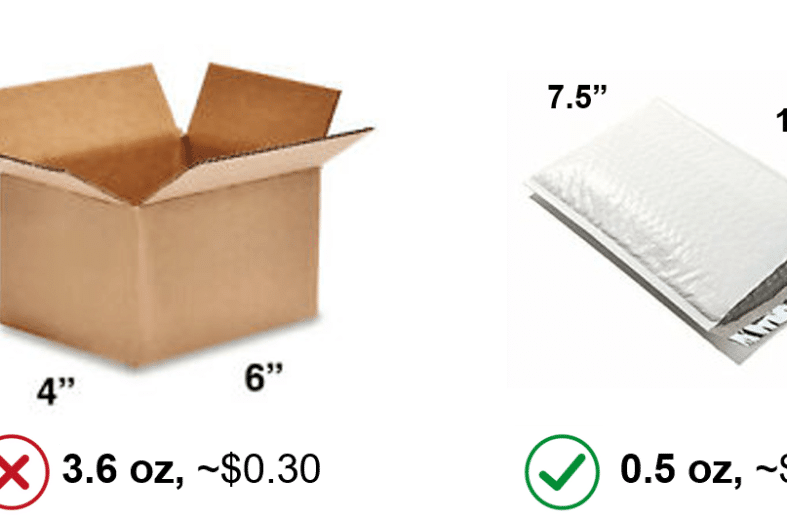
Another source of cost-cutting is using carrier boxes or packaging. All carriers give away free packaging for specific classes of mail. If you are shipping within that service, buying a separate box and affixing the label on to it may be more costly than just going with the carrier boxes.
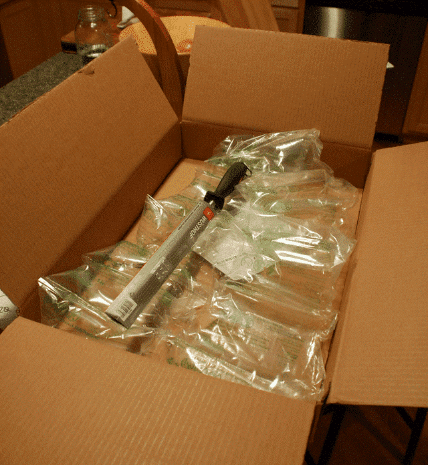
Knowing what amount of each item you ship most often can also help you reduce your costs of packaging. Figure out the most frequent order number and get the packaging that is optimum for that order. For example, you may be using the same package to ship multiple quantities of an item like soap. But if your box is designed to accommodate 5 numbers and you are mostly shipping 2 items at once, you should consider getting a separate smaller package and save money by shipping for less. It increases complexity but will save money over time.
Pros:
- Sellers can reduce the shipping rates as well as the cost of packaging at once.
- Smaller packages are easier to dispose and produce less waste
Cons:
- Reduces negotiation power with carriers with a lower volume of a single size of packaging.
- It adds the complexity of continually assessing and changing the packaging required to fit the ordered quantity and new SKU’s.
42. Reuse Packaging from Inbound Orders
There are two main benefits of reusing supplies from inbound orders, one is reducing waste and two is reducing the supplies you need to buy. Packaging supplies like boxes, fillers, or padding may look trivial but can pile up in costs. Mainly because they apply to every parcel shipped.
If you offer fragile or sensitive items that require special packaging, chances are some materials from your inbound shipments can be reused. Reusing fillers like bubble wrap, peanuts, paper, or crinkled paper can reduce your spending on new supplies while reducing waste. Of course, the amount you can reuse may vary from each seller, but it’s generally a better idea to reuse before finally recycling them.
Pros:
- Retailers can reduce expenses while reducing the overall waste produced by their business.
- It reduces the risk of carrying additional supplies for new online sellers in case the sales are erratic.
Cons:
- The unboxing experience for the buyer may not great with reused packaging.
- Ecommerc sellers should be wary of not compromising on the integrity of product safety over saving a few cents.
43. Use Prepaid Shipping
Businesses have used prepaid shipping in the context of returns and business reply mails. But prepaid shipping can be equally applicable for certain online stores to ship items to the customer. If a seller uses national carriers such as FedEx and UPS, using prepaid shipping can discount the shipping rate up to 20 percent as opposed to printing labels for each parcel individually. How it works is that you order and prepay shipping labels in bulk ahead of time to get volume discounts, then use it to fulfill orders.
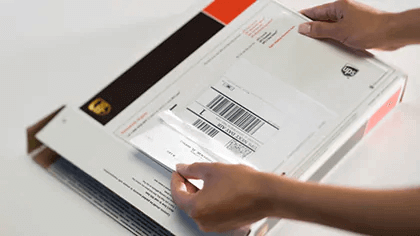
Of course, this only works if you know your shipping destinations and therefore is applicable to businesses who work on subscription models. In such a case, the deliveries are scheduled at regular intervals to fixed customers. A good estimate of the kind of packages you are going ship (in terms of weight and volume) can prevent you from buying too much.
Pros:
- Prepaid shipping is a good option for small online sellers without contracts and a few SKU’s.
- It minimizes the effort to ship the items eventually.
Cons:
- Sellers can get better discounts for larger volumes.
- It does not make a huge difference for sellers using USPS as their carriers.
44. Consolidate and Deliver on Fixed Dates
Explore the possibility of consolidating all your orders and ship them all together on dedicated days. This strategy can be used in conjunction with zone-skipping mentioned earlier. There are 2 ways of doing this, (1) is to fulfill end customer orders, like in crowdfunding campaigns and preorders and (2) when transporting goods between your warehouses to retail outlets.
For the first one, Boardgame Kickstarter projects often use this method to offer the cheapest shipping options possible. For example, Trial by Trolley a recent campaign raising more than $3.5M has an estimated delivery date of December 2019 and charges $10 for US shipping. Having one day of delivery allows them a simpler shipping process (just one time), and the delivery expectation allows them to use ground shipping to send the finished products.
For the second one, this works well if you have a brick and mortar presence. The main idea is delaying inventory replenishment until you have a full truckload of goods per shipment. Shipping efficiently (a full truck) reduces the logistics cost of each item carried. Having a good demand forecast is key in minimizing stockouts and estimating optimal shipment schedules. A set shipment schedule provides carriers certainty of future business and can help in your negotiations as well.
Pros:
- It consolidates order fulfillment into one dedicated shipping day/period for preorders
- It improves shipment efficiency between warehouses or warehouse to retail outlets.
- Consolidated shipping reduces the touchpoints for all the parcels from a seller to buyer reducing the risk of damage.
Cons:
- Not recommended for end-user shipping due to rising fast shipping expectations, except for preorder items/crowdfunding.
- Online sellers will need careful estimation to replenish stocks at full truckloads and ample safety stock.
- It requires negotiation and management of bulk shipping with a logistic provider.
45. Offer Date-Certain Shipping Option
When free shipping is not an option, showing guaranteed delivery dates helps manage customer’s shipping expectations. Online sellers should explore offering customers options for different delivery dates with different shipping charges. The slowest one might be offered free, but it still has a guaranteed date of delivery.
Guaranteed dates also help customers to make decisions faster because it takes out the mental math of “delivers in 5-7 business days”. Amazon and Walmart have used this shipping strategy for its marketplace. Amazon has increased the accuracy of delivery date moving from a range to a specific date because of this very reason.
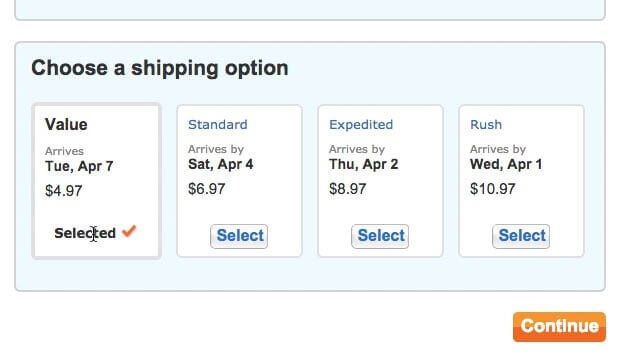
A seller should keep a couple of things in mind while implementing date-certain shipping options. They should create a sense of urgency by showing how long the date of delivery will be valid before it changes as the shipping window changes. Moreover, the tracking should be made available to the customer in great detail to create transparency and further decrease the anxiety.
Such options ease the process for customers because they can see the trade-off between spending more and delayed delivery. This lets different types of customers choose and complete purchase depending on their priority.
Pros:
- Showing dates takes out the mental math of delivery dates from customers
- Customers can make decisions for themselves on how important money vs urgency of delivery.
- Retailers don’t have to target a specific customer profile and provides options for all types of customers.
Cons:
- It creates complexities of shipping the same SKU through different carrier services for different customer.
- The chances of cart abandonment may increase as customers take more tie to decide and find other options.
You can also see a quick video of this episode here.
Part 10 – Look to the Future
As we conclude The Ultimate Guide to Profitable Free Shipping, the last section is going to look at the future of shipping. Innovations in the sector have been driven by the rising cost of last mile shipping and warehouse management. They are already being implemented by big players in the order fulfillment industry in some capacity and, with time, most of them will trickle down to every ecommerce seller.So you should be aware of how these technologies will shape the future.
Points 46 through 50 talk about technological innovations that are driving the shipping industry forward:
46. Warehouse Robots
Autonomous mobile robotics (AMR) is an exciting innovation in warehousing operations. Amazon is leading the way with large scale deployment of robots in its order fulfillment centers to reduce the costs of the pick-and-pack and sorting.
The robots help in eliminating the cost of employing human labor and increase the efficiency. There are less mistakes and more speed when a robot conducts an operation. Currently, order fulfillment centers have robots work alongside humans to transport many items at once, in some cases the complete racks, to stations manned by humans.
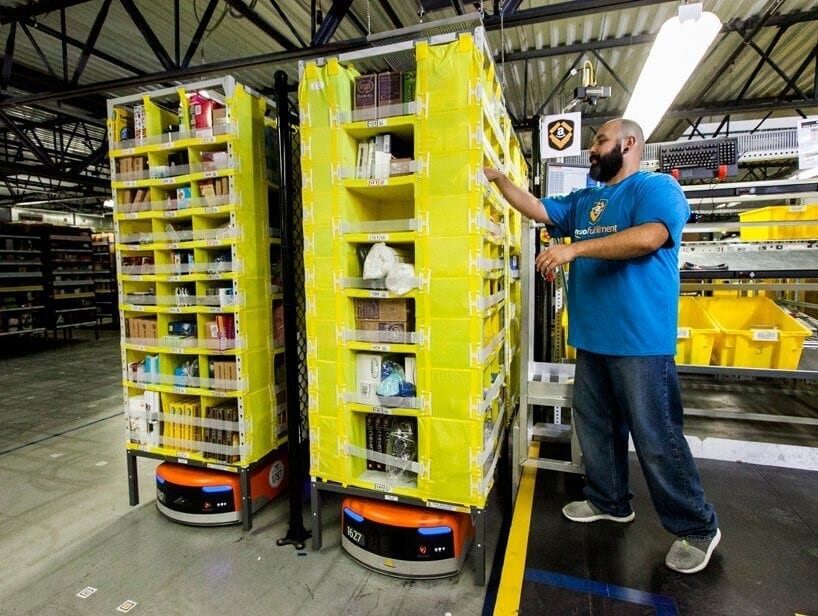
In other cases, robots speed-sort items by weight and volume to be packaged accordingly for different shipping services. This reduces the chance of human-error while increasing the speed.
Kiva and Takeoff have been two breakthrough robot developers that have helped lower costs significantly for ecommerce sellers. Kiva has since been acquired by Amazon and taken off the market for exclusive Amazon use.
Takeoff specializes in micro-fulfillment centers. It focuses on grocery deliveries by taking orders from a large set of customers.
According to Amazon in 2016, Kiva robots cut the cost of warehousing by 20%, which amounts to more than $20 million dollars for the warehouses where it was deployed. Since then it has been estimated that Amazon will potentially save $800 million when the robots are deployed to all facilities.
Using robots has helped Amazon cut the time required to fulfill each order. At the same time, it has allowed better utilization of space by building narrower isles and getting rid of handling mechanisms that were required before.
To start with, for a warehouse without any robots, simple solutions such as Automoted Guided Vehicles (AGV’s) can be an entry level solution. They are used extensively on factory floors and follow a predetermined path to transport materials without human intervention. This helps reduce manpower. Another solution could be Autonomous Mobile Robots (AMR’s) that can identify their environment and information on packages. This lets them sort packages, thus reducing human intervention even further.
Pros:
- It decreases order fulfillment cycle time, which means after the orders are received, they leave the warehouse earlier than before.
- Along with the decrease in costs, automation helps increase safety in the warehouse.
- Robots can work around the clock, increasing the productivity of a warehouse.
Cons:
- Currently, the return on investment is profitbale for high volume fulfillment operations only
- Additional resources for implmenting and maintaining the technology products are required.
47. Drone Delivery
Drones are unmanned aerial vehicles (UAVs) that can be used to deliver lightweight items over short distances. Currently it is being piloted all over the world for critical deliveries such as medicines to remote areas. In some cases, though, they are being tested to replace the conventional last-mile delivery in postal services.
Israeli startup Flytrex conducted a pilot program for delivery in Iceland in 2017. And an American startup Matternet is experimenting with deliveries in North Carolina. Google also launched it’s own drone delivery service called Wing which will start its pilot program in Canberra, Australia.
There are several advantages to using drones for deliveries as it opens up a new medium of delivery unlike existing congested routes.
However, there are still many hurdles for drones to become mainstream, the biggest of which is regulation framework to ensure secure use of drones to avoid any conflict with privacy and safety.
Drones are also not tested for different weather conditions, unpredictable events and deliveries in dense urban residences such as apartments in Manhattan.

Retailers can hope to benefit from the efficiency of drone deliveries once the carriers roll them out. It will help lower the cost of last-mile shipping overall. Another possibility could be an aggregator service for local deliveries that replaces current services such as Postmates and Doordash. It will atleast reduce the dependence on carriers for local deliveries.
Pros:
- Reducing congestion as delivery vehicles will not operate on the road.
- Better routing of packages as air-travel does not depend on roads and traffic.
- Improved safety as less touch-points along the way from warehouse to the customer.
Cons:
- The regulations are, currently, very rigid regarding the public use of drones.
- Drones have fundamental limitations to operate in certain conditions such as apartments and unplanned neighborhoods.
48. Robotic Last-Mile Delivery
The biggest challenges in last-mile delivery are low capacity of conventional postal systems, cost of labor, cost of repeat deliveries and increased traffic congestion. All of these contribute to high cost of last-mile fulfillment currently. There has been no innovation in this part of shipping process for decades, until now.
Delivery robots are small mobility robots that can deliver items to individual houses by navigating the unique challenges of last-mile delivery. Drones have their limitations as explained in the previous section. As an alternative, robots that work in conjunction with manned or autonomous delivery vehicles to bring the item to door step are being tested. Robots are physically located on the vehicles and disperse as the vehicle approaches the vicinity of the destination. These systems are an improvement on current system and do not need radical changes in regulations and infrastructure.

Some of the early innovators in the space are Boxbot, Marble, Nuro and Starship. Even Amazon and FedEx are testing their robotic systems for last-mile order fulfillment. FedEx has partnered with DEKA which also invented Segway while Amazon is testing its robot Scout for deliveries in southern California.
Just like drones though, sellers will have to wait for carriers or aggregators to prove and deploy the technology on a large scale to reap the benefits of lower costs.
Pros:
- Delivery robots are one-to-one replacement of current last-mile delivery mechanisms, and therefore are able to operate seamlessly with existing supply chain.
- Delivery robots have less regulatory limitations and therefore, easier to commercialize.
Cons:
- The robots may face limitations in dealing with complex situations such as new constructions and dealing with different acceptance mechanisms in buildings.
- The robots are also prone to damage from sudden weather events or unpredictable events involving humans.
49. Amazon Key
Amazon launched its program Amazon Key in conjunction with GM and Volvo, two major players in Automotive across North America and Europe.
It operates under prime delivery that allows deliveries to cars parked on the streets or other accessible parking. It works with the car’s central locking and GPS systems which can be accessed through the cloud. The customer has to opt-in but given the convenience offered, it can be a game changer, as it reduces the frequency of missed deliveries and increases the speed of shipping to customers.
If the customer has a smart lock at their homes, Amazon key also enables deliveries right inside the homes. The cost associated with repeated deliveries and inconvenient trips to post office for collecting packages are eliminated if the customer opts-in to this service.
Currently it’s not applicable for third-party seller items and large items but Amazon could extend the program soon for all sellers using FBA.
From the customer’s side though, there are major concerns regarding the privacy which can slow down the acceptance of this offering.
Pros:
- It reduces the overall shipping rates by decreasing the costs associated with repeat deliveries because of unavailability of the customer during delivery.
- It increases the value for customers with smart homes and connected cars by providing more convenience.
Cons:
- There are concerns of privacy and safety by giving access to personal space to external providers.
- The service will not be directly available to individual sellers as it requires high level of technological integration between companies and associated security measures.
50. Peer-to-Peer Order Fulfillment NetworkTM
Throughout the Ultimate Guide we have seen various manners of relationships and technologies being used to offer convenient forms of shipping. For example, the hybrid shipping service illustrated the concept of collaboration between competitors. However, we haven’t seen collaboration between ecommerce sellers themselves to address their shipping concerns.
Cahoot is a unique peer-to-peer order fulfillment network where top-rated merchants and 3PLs collaborate to decrease delivery times, increase margins, and boost customer satisfaction without compromise. It harnesses a vast nationwide network of trusted and verified peers to fulfill orders more efficiently.
Alternatively, Cahoot also offers outsourced fulfillment where merchants can place inventory across its vast network of warehouses and have Cahoot fulfill your orders. This is an excellent option for merchants to offer profitable free and fast shipping without operating their own warehouses.
The unique advantage of using Cahoot is that online sellers can scale their shipping capability using their existing order fulfillment facilities. The shipping costs decrease by 40% while the delivery times reduces as well by up to 2 days. There are no additional costs of inventory distribution and outsourced fulfillment.
Cahoot seamlessly integrates with each verified Seller’s account, analyzing every incoming order. Its patented platform identifies merchants best suited to fulfill each order, based on the promised delivery date, lowest shipping costs, and the warehouse’s geographical location. Cahoot automatically generates and sends the shipping labels to each merchant while updating the tracking information in Seller’s accounts.
Pros:
- Increased profitability and speed enables online sellers to offer free and fast shipping across the country, increasing their sales.
- It enables instant inventory replication at multiple warehouse without any investment, virtually creating endless inventory.
- The retailers within the network are able to increase the profitability and sales for each other at the expense of retailers outside the network.
- There is much greater visibility into every step of the shipping process including the partner and carrier actions.
- The sellers don’t need to change any of their order fulfillment capabilities or practices.
- It integrates with the existing shipping software to increase the overall value.
You can also see a quick video of this episode here.
Offer 1-day and 2-day shipping at ground rates or less. Schedule a call to find out more.
